I never thought that I would arrive in Hong Kong and feel cold! But, after 34oC in Manila, it was no warmer than 16oC during our stay in Hong Kong and colder than that when we arrived before daylight. We were soon retreating from the balcony to dig out the fleeces before we went out again.
Margaret had been out since very early, as soon as she saw any lights, excited at the prospect of arriving in Hong Kong, as it is such an iconic destination. It is also the first place on this cruise that we missed on our 2020 COVID-blighted world cruise. We entered the harbour from the east. The ship’s captain explained that there is a one way system through the harbour – entry from the east and exit to the west.
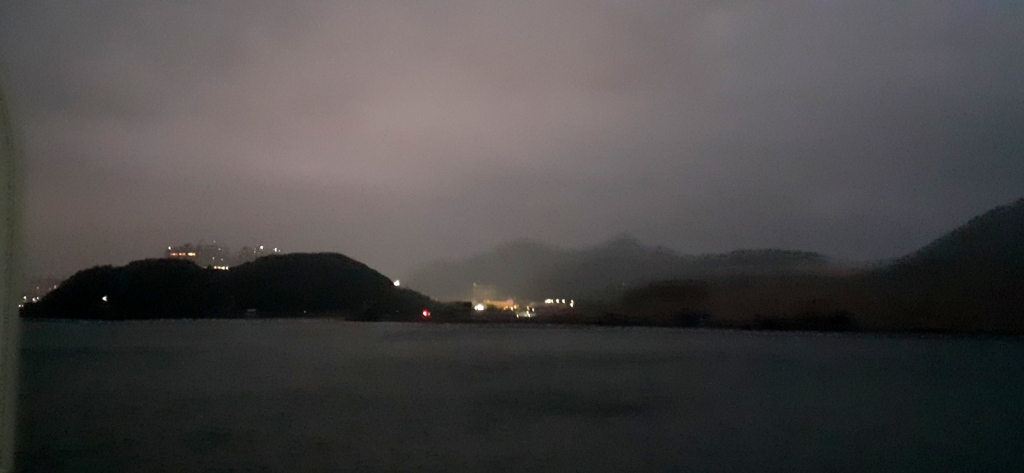
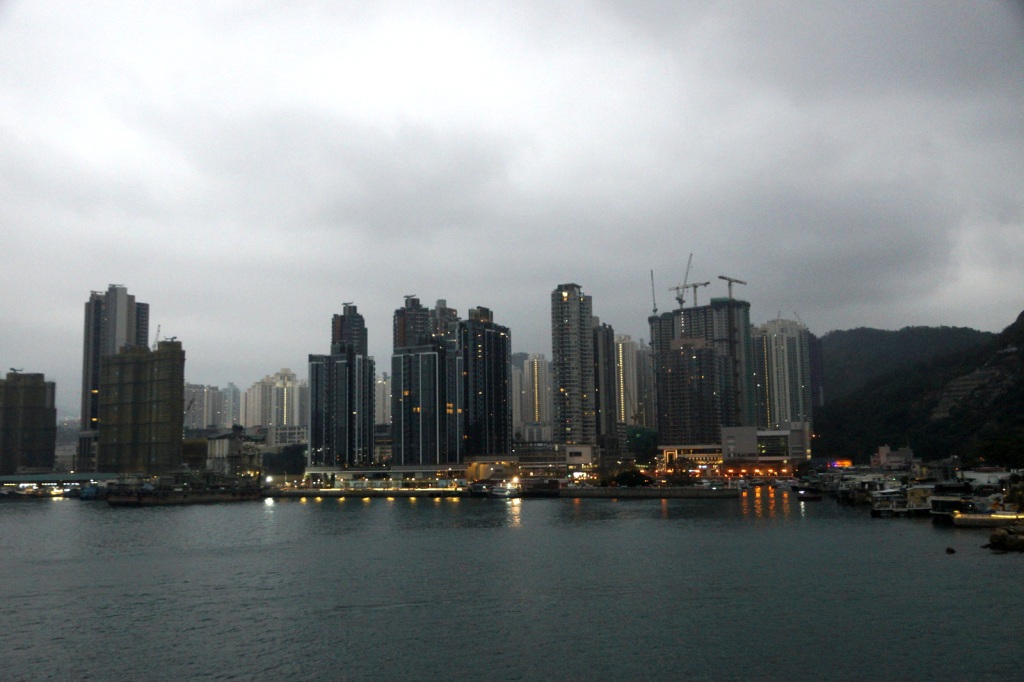
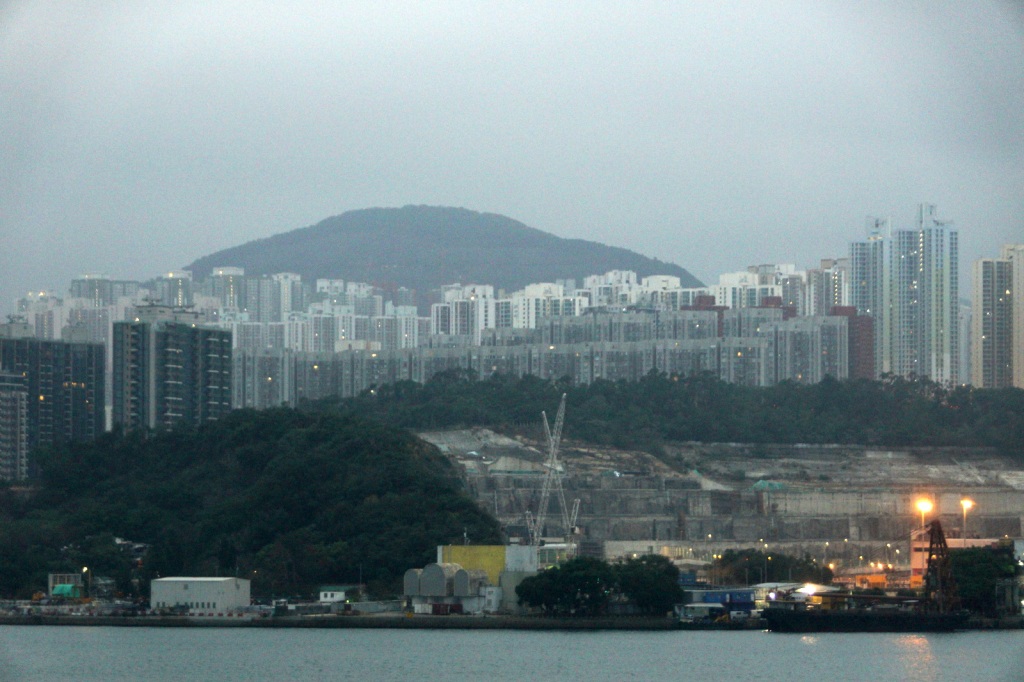


As the light rose, we saw the full prospect of the towering skyscrapers in Hong Kong Island and opposite on Kowloon. Our berth was right in the centre of this as we were not at the new terminal, on the old airport, but at one of the old terminals, right next to Star Ferry Pier. A few common birds included Black Kites flying around the skyscrapers, plenty of Great Cormorants and a few Little Egrets.
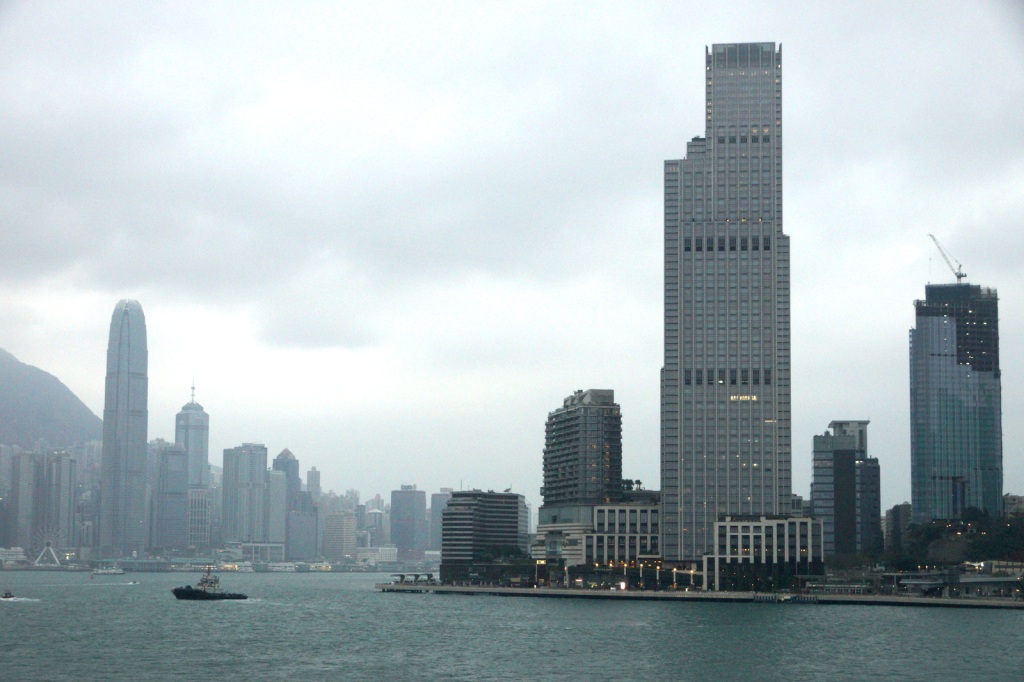
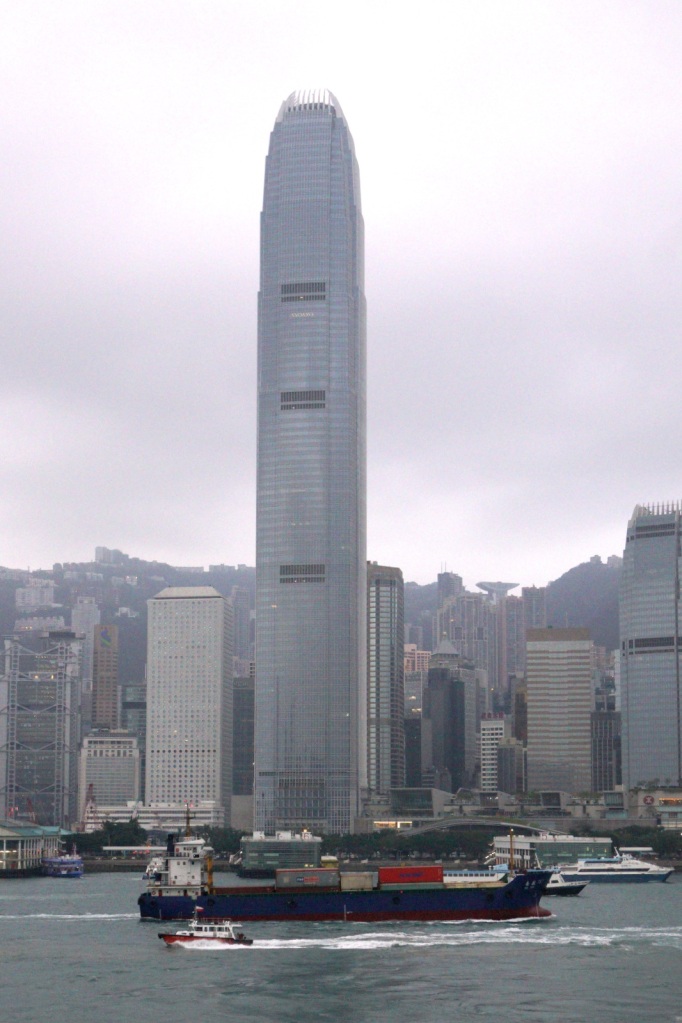

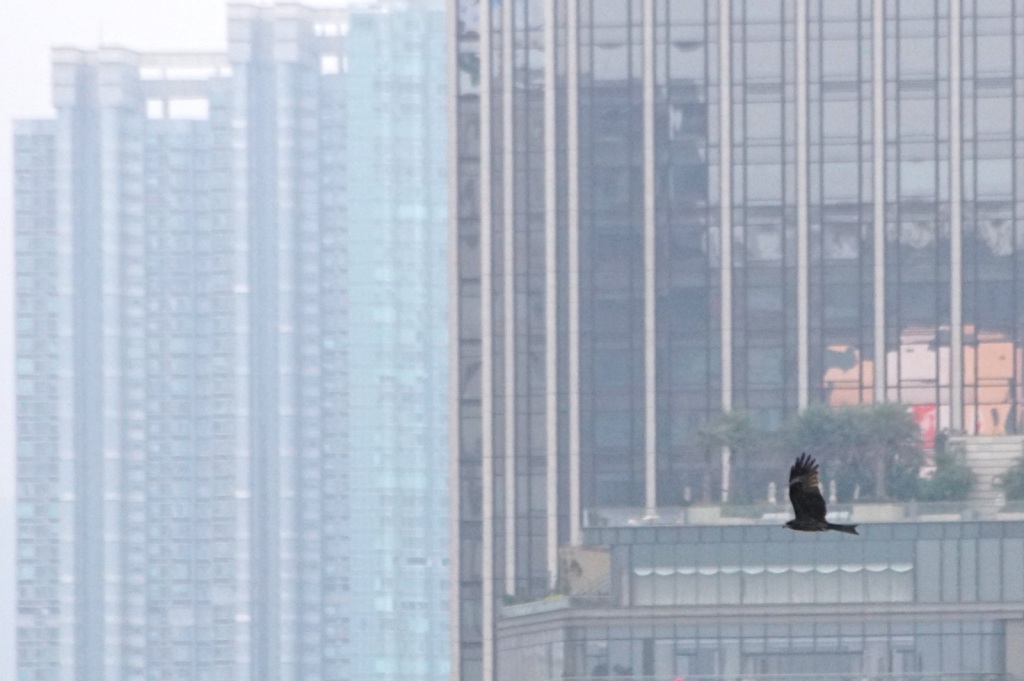
We were soon ashore, without any real problems, but we found ourselves in a vast and very shiny shopping mall, which was almost completely empty as it was Sunday morning. We kept heading on one direction and finally found an exit which took us straight to Star Ferry Pier, which was also bus terminus and had a few shops and an ATM. Soon afterwards we had ‘tapped in’ with contactless cards and were sailing across Hong Kong harbour on the ferry – for the princely sum of 37p.
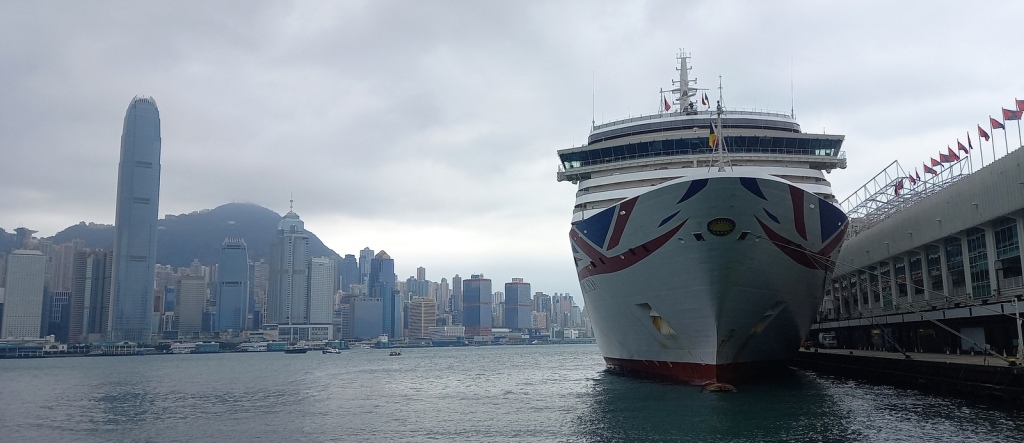

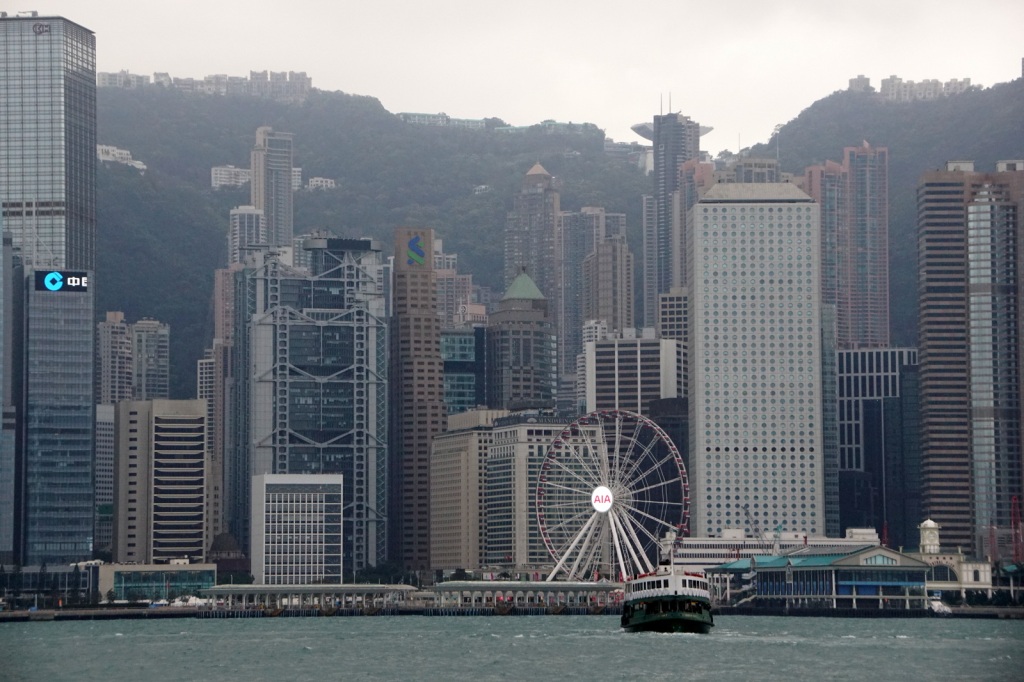
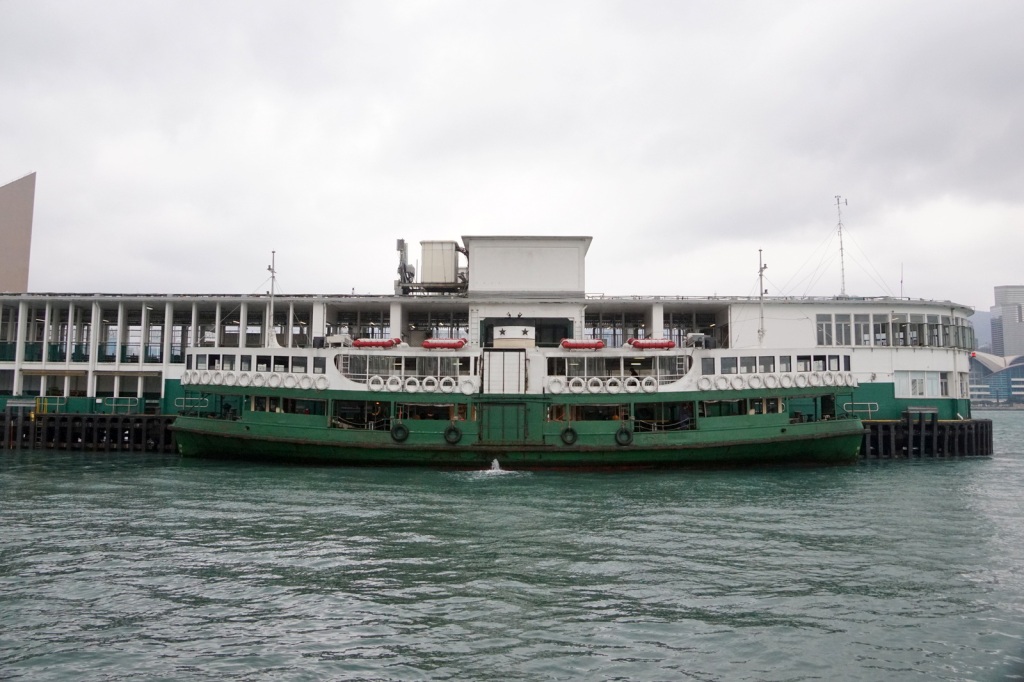

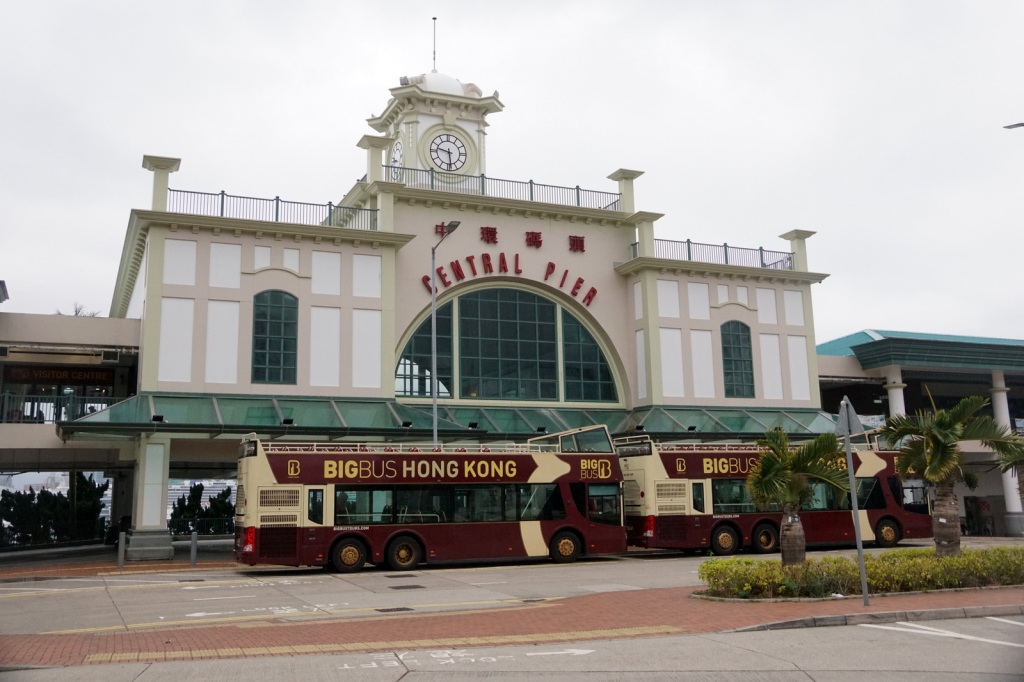
We were heading to the Peak tram, and it didn’t look too far on the map, but, as usual, we might have been better getting a taxi. It was interesting though. A musical song coming from some trees outside a hotel turned out to be coming from a couple of Black-collared Starlings, which was a nice start to the birding. Then we passed a tiny green space named Chater Garden which despite its tiny size held Red-whiskered Bulbuls, Light-vented Bulbuls, a pair of Oriental Magpie Robins and four Crested Mynas, as well as the ubiquitous Tree Sparrows. Margaret saw a Red-billed Blue Magpie, which I missed.

We viewed this garden from a covered overhead walkway, something which was quite common to help pedestrians navigate the busy Hong Kong streets. What was slightly confusing was that these walkways were full of people, all women, sitting out on flattened cardboard boxes. At first, we thought that they were homeless (but I couldn’t see the Hong Kong authorities permitting this) but our guide the next day told us that they were (mainly) Filipino employees, meeting up on their day off (it was Sunday). As they did not have much money, or were sending it all home, they tended to meet outdoors. Perhaps because of the forecast rain they were meeting under cover. This explained some of the other things we saw. There were several groups playing cards, other painting each other’s toenails or fingernails – even an outdoor hairdresser.

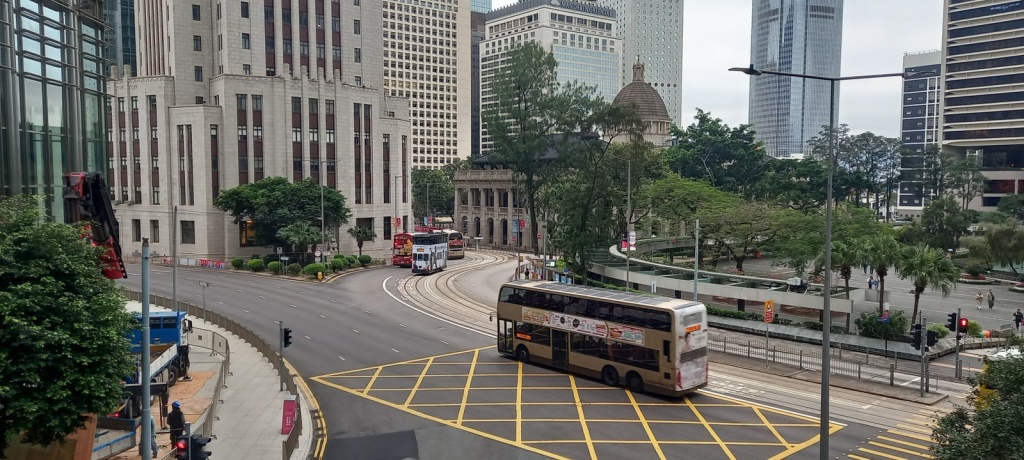
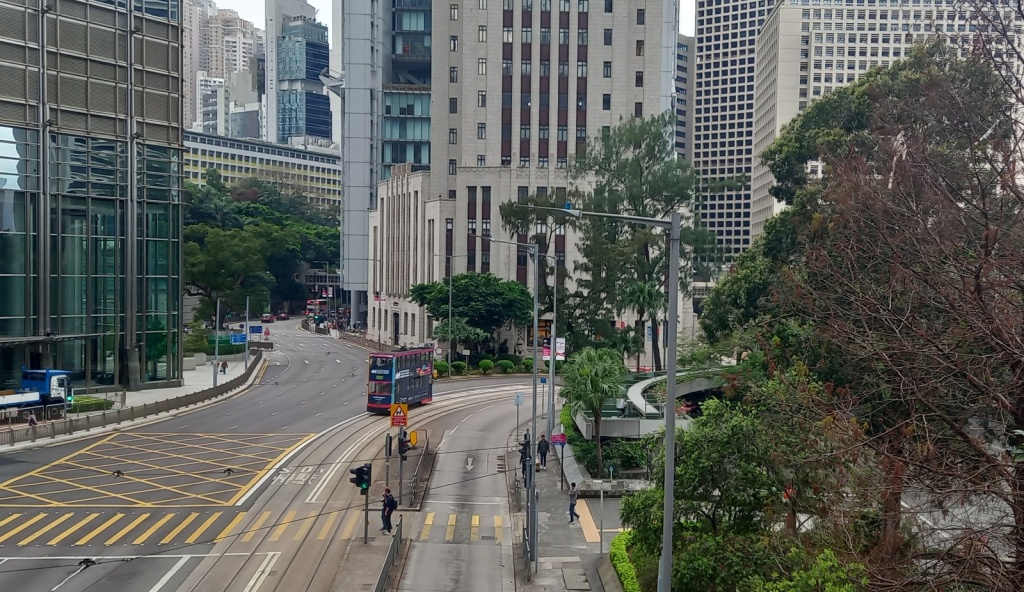
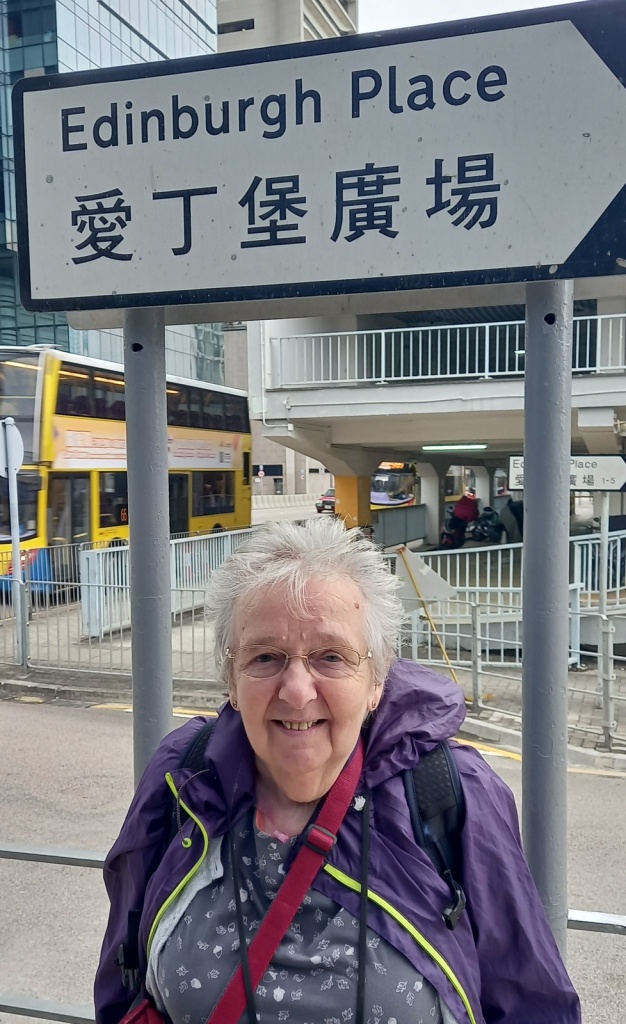
We reached the Peak Tram Terminus. Like many things in Hing Kong you could be right on top of it and not know it was there. Every square (cubic?) centimetre of space was utilised and the trams themselves were completely invisible from the street. We bought our tickets and then waited in a large hallway to wait for the doors to open to allow us onto the platform itself. A video fresco covered the walls and ceiling, showing what the forest on the peak was like before humans wrecked it.
The Peak Tram is a 1.4 km long funicular railway which opened in 1888 to give access to Victoria Peak. It is very steep and looking out of the windows was quite disorientating at times, as the skyscrapers were at strange angles.
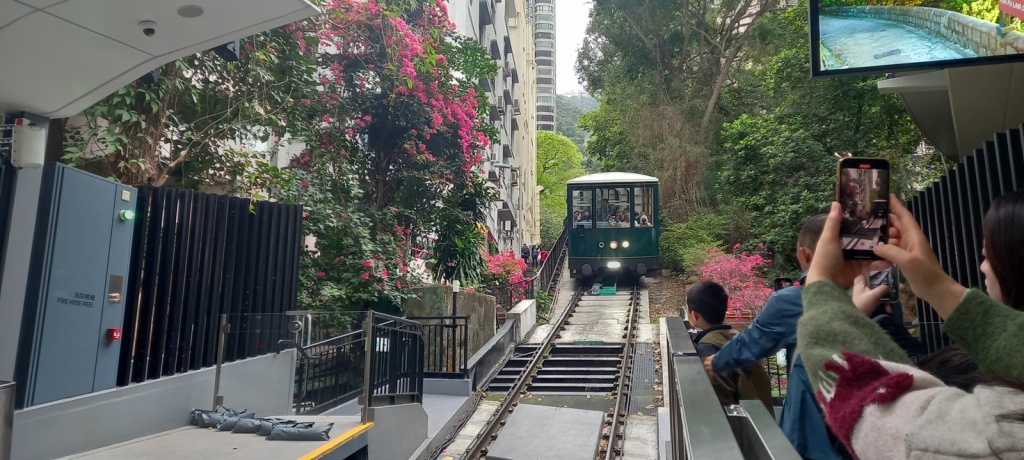
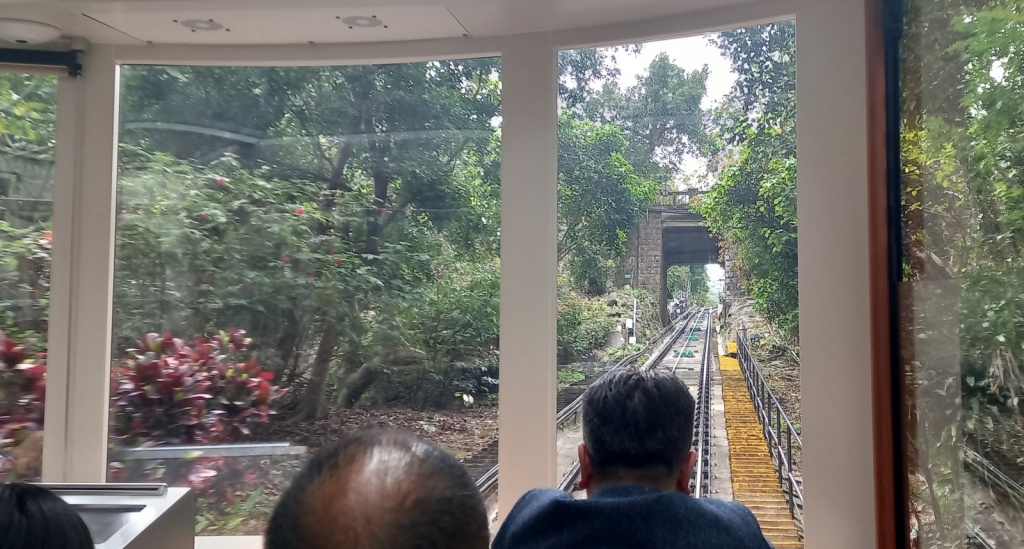
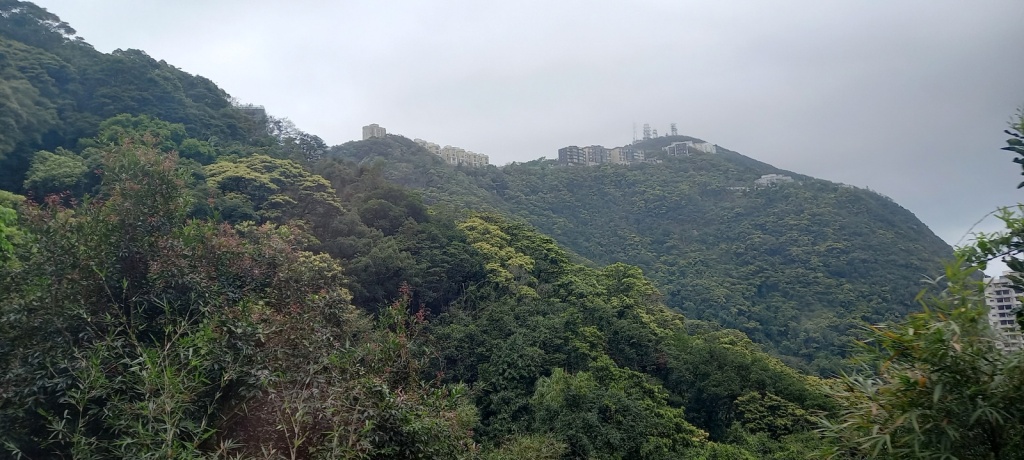
In what was to become a theme of Hong Kong, we got out at the top into a mall and couldn’t find our way out. The strangest sight was being greeted by a waxwork of Benedict Cumberbatch, promoting Madame Tussaud’s Hong Kong. Still not as strange as being greeted by Amy Winehouse in Iguazu in Brazil.
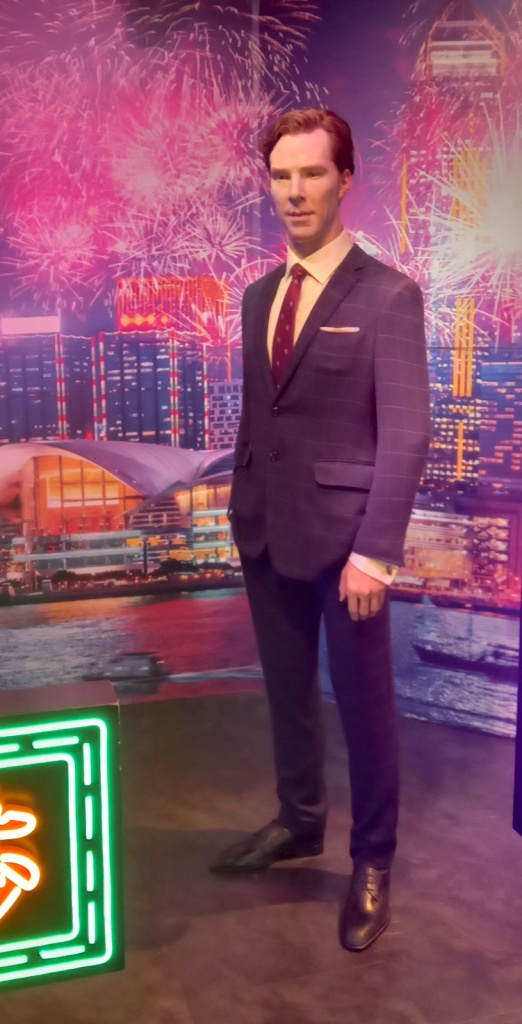
We thought we had paid for the Skytower at the top when we bought our tickets but it turned out we hadn’t. It was probably just as well. The cloud had descended by the time we got there. We could see Victoria Peak when we set out but it was wreathed in mist now, and very little of Hong Kong could be seen from the top.
Even worse than the cloud, was the wind. It was really quite gusty and it was distinctly chilly. We began to wish we had brought more than just a fleece! A warm beverage of choice was required. There were lots of franchise outlets up there, but we spotted what I assume was the original peak top café before it was all over-developed, which was a much more pleasant environment. They were still serving from the breakfast menu, so we ordered pancakes with maple syrup, strawberries and blueberries. As we ate, two ambulances and several fire engines appeared and parked outside – I assume someone had fallen down one of the steep slopes.
After warming up we followed the sign for the Peak Gardens. The tram terminus is not at the top of Victoria Peak, there is still some way to go. We got as far as a small park before we descended again. It was only getting cooler, windier and cloudier. There were a few birds in the small park – about 15 Swinhoe’s White-eyes, an Oriental Magpie Robin and a pair of Fork-tailed Sunbirds, high up in a tree.

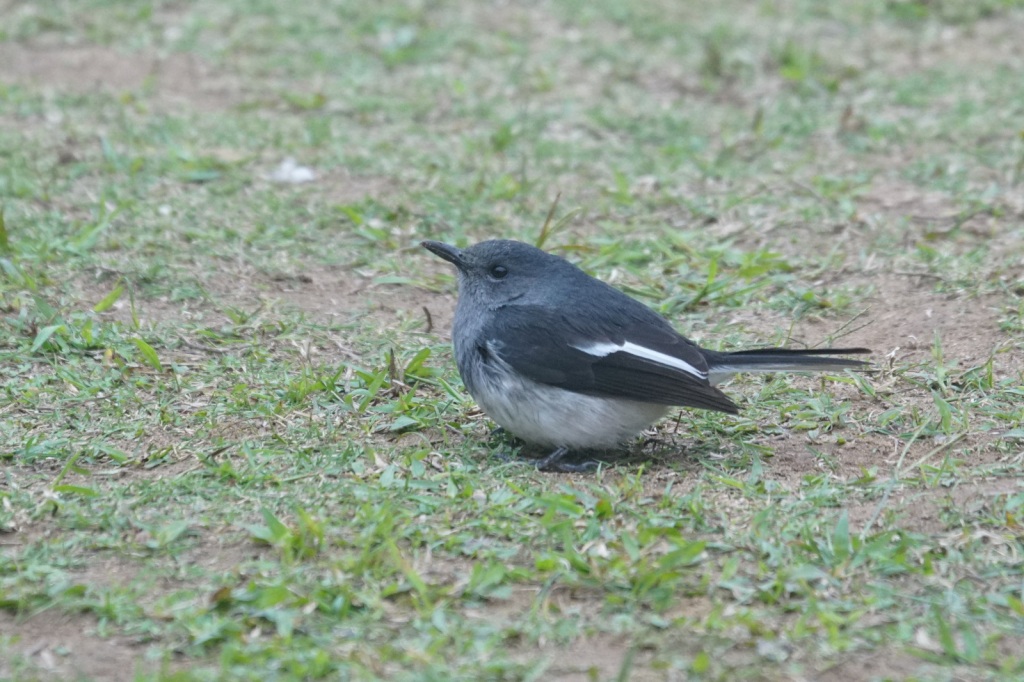
On our descent along the road back to the tram I heard a Yellow-browed Warbler and looked up and there it was. These appear in Shetland every year, and are getting much commoner, but there is always something nice about seeing birds like this where they should be – not on its breeding grounds, unfortunately, but in their normal wintering range.
We took one last look at the blustery view before we descended, just in case it had reappeared.
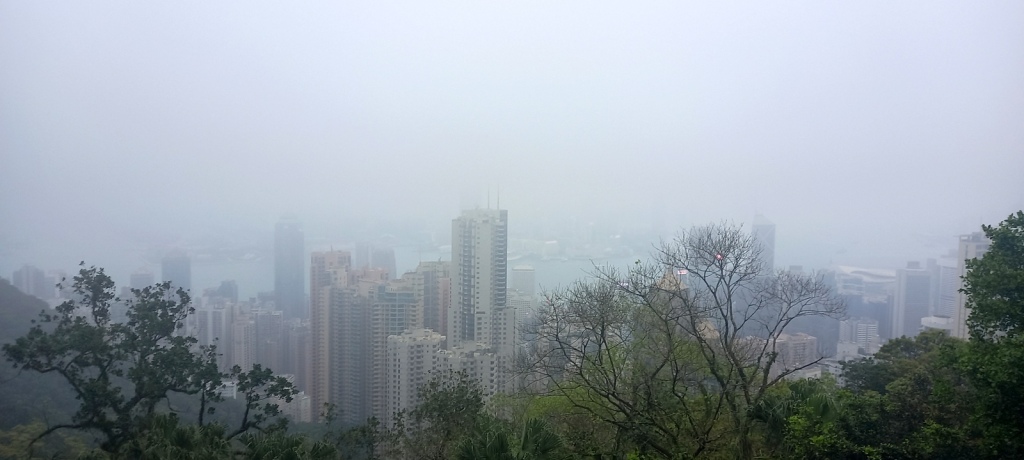
Upon leaving the tram terminus there was Hong Kong Park, according to the maps, but again it was invisible until we turned a corner and saw the entrance. The park was clinging to the hillside nestled between the high-rise buildings, but it was a very pleasant little green space, with some small ponds, some wild corners, a couple of aviaries and so on.

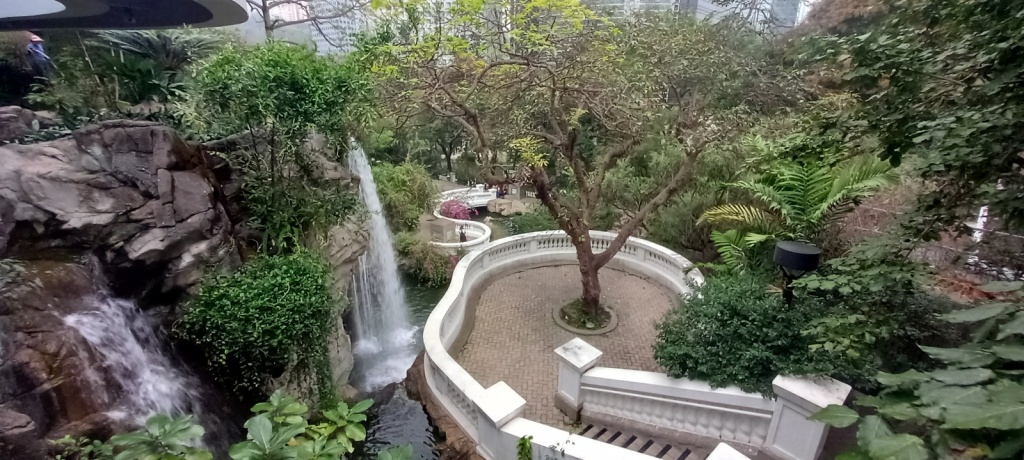
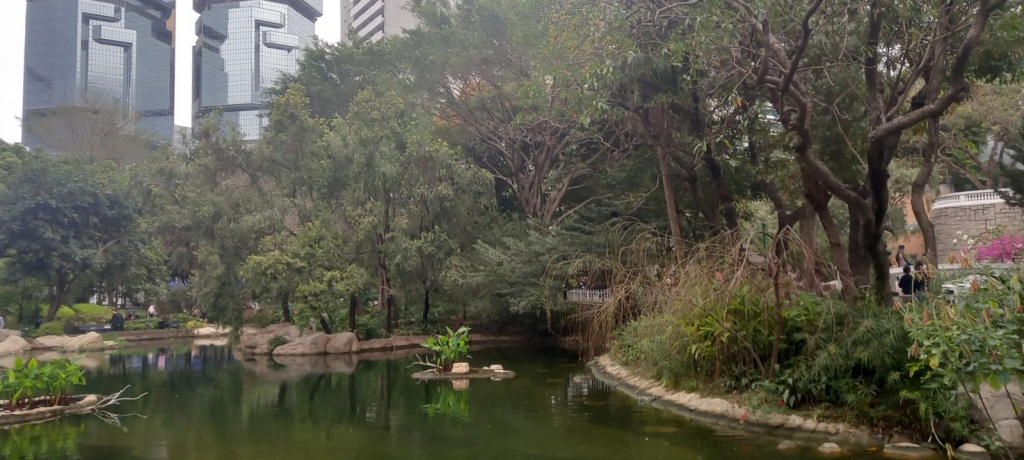
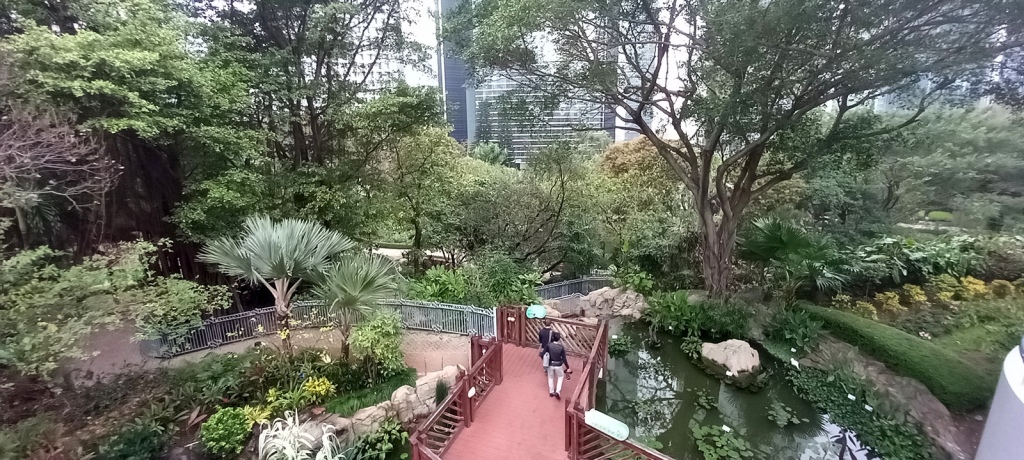
Feral Yellow-crested Cockatoos were among the most obvious birds, due to their typically raucous calls. I finally got to see a couple of Red-billed Blue Magpies, the bird I had most wanted to see when we went to China in 2002, but had failed to see. A couple of Common Tailorbirds were in one of the wilder corners, along with a Four-clawed Gecko sitting on some steps.
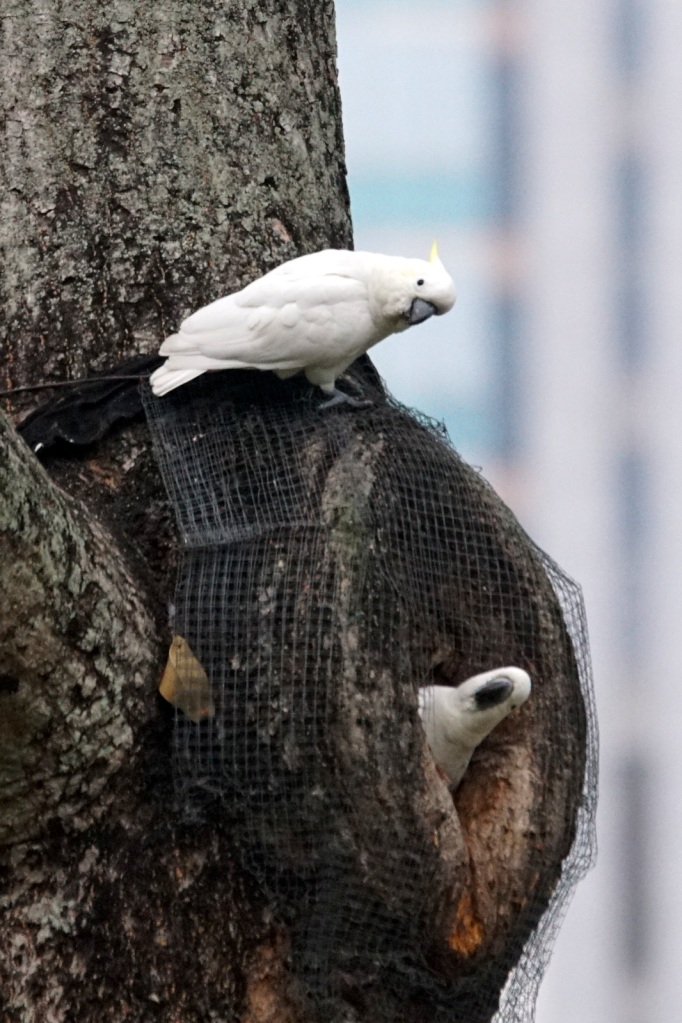
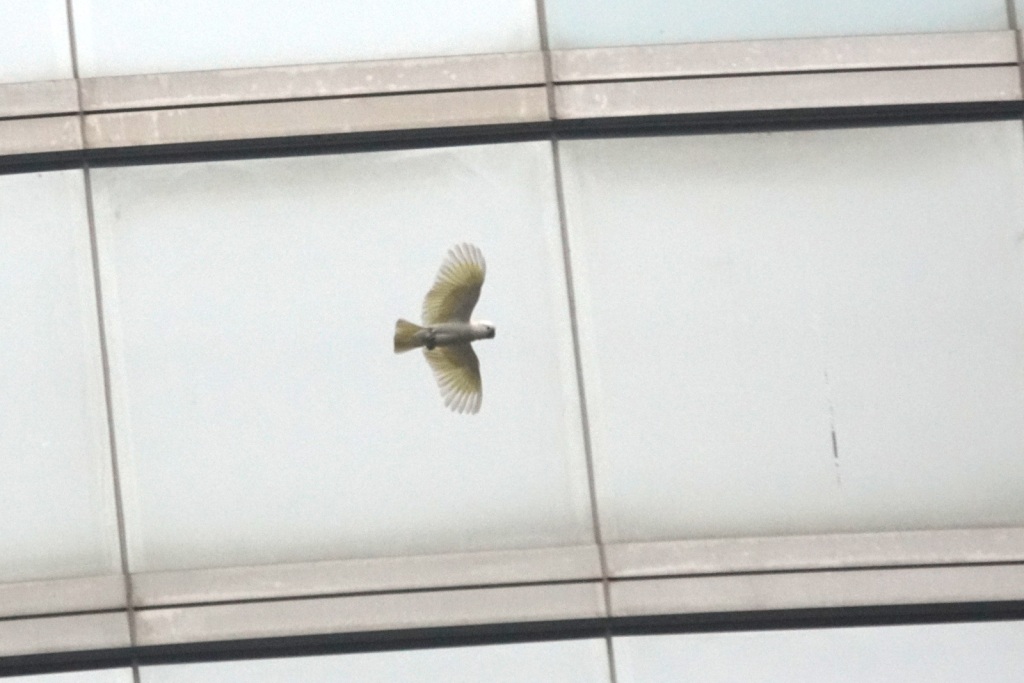
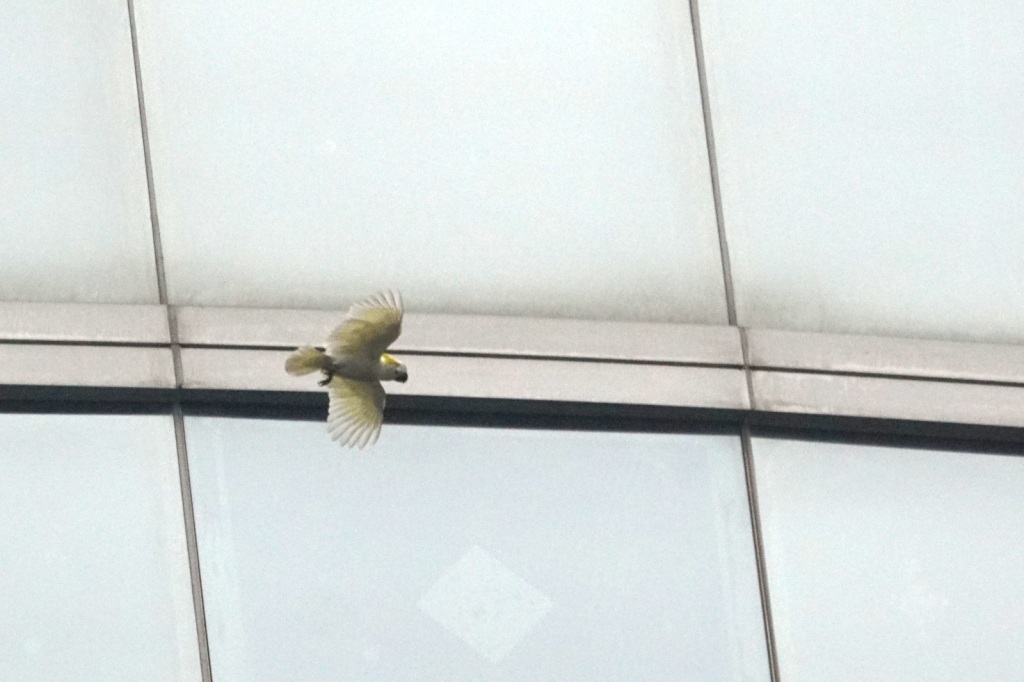
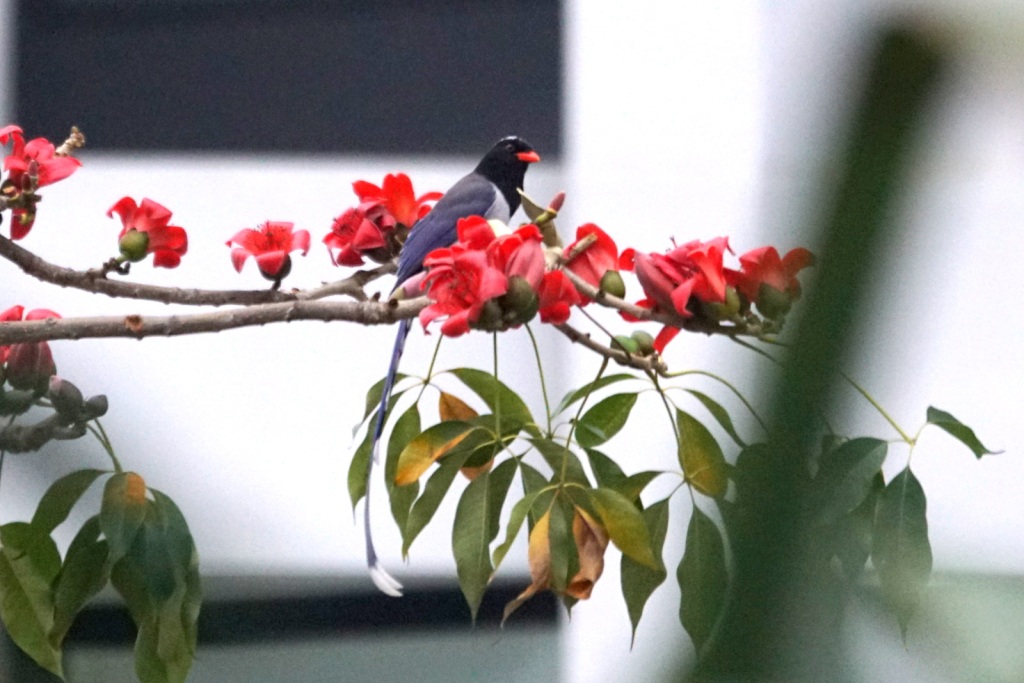
There were a couple of large Red-eared Terrapins, natives of North America, in the pond, despite a notice telling people not to release fish or terrapins.
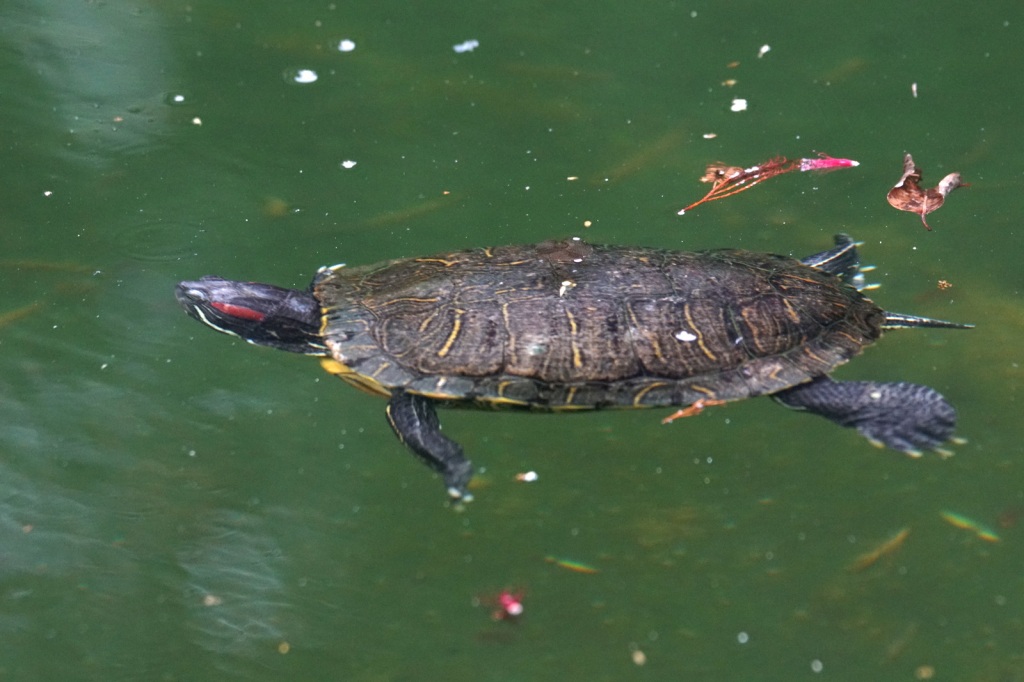
Beside the ponds we came across a group of Masked Laughingthrushes. Margaret saw them and commented that they didn’t look at all like thrushes (which is fairly true) but they looked more like teddy bears (and she had a point). Our guide the next day told us the Chinese name for Masked Laughingthrush translates as ‘Seven Sisters’ because they go round in groups and make a lot of noise (!).

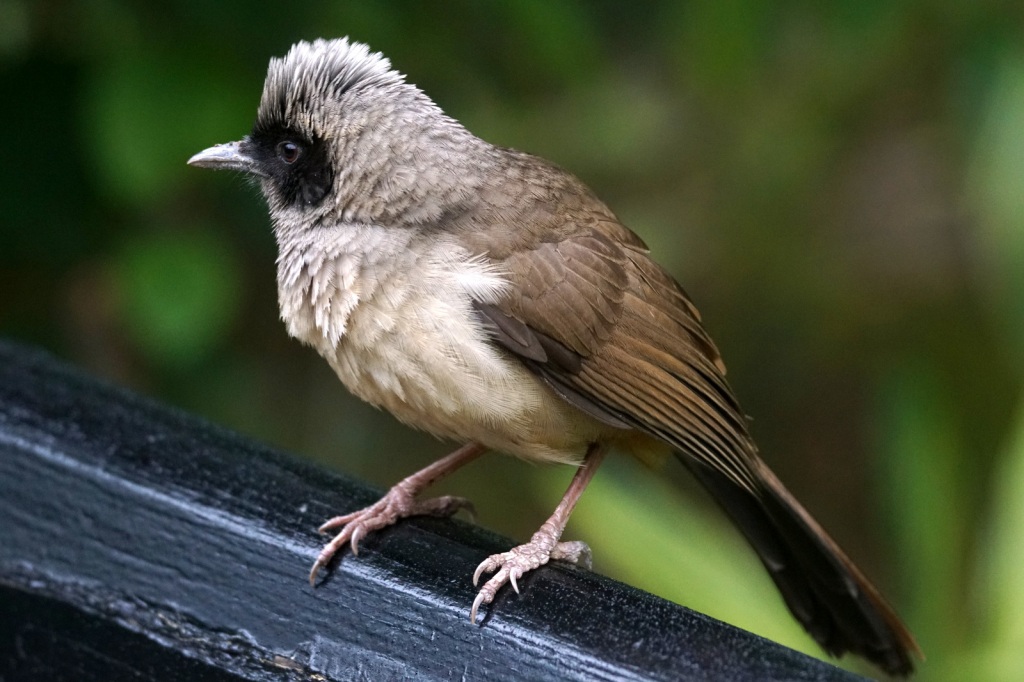
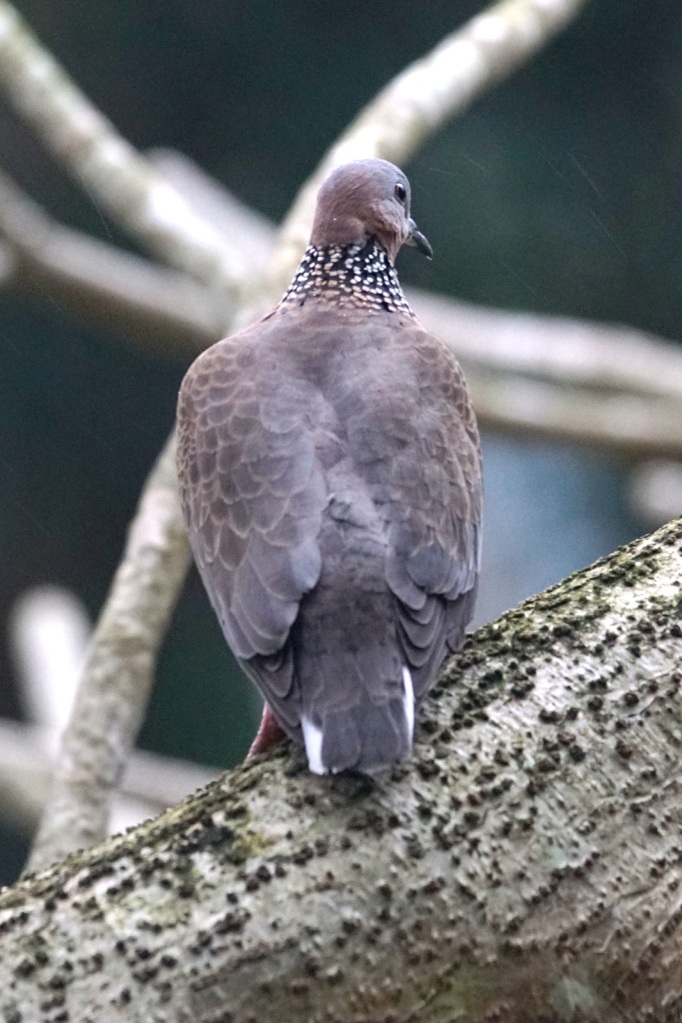
By the exit there was a rather clever fountain which allowed you to walk underneath so it looked, from most angles, as though you were completely surrounded by water.
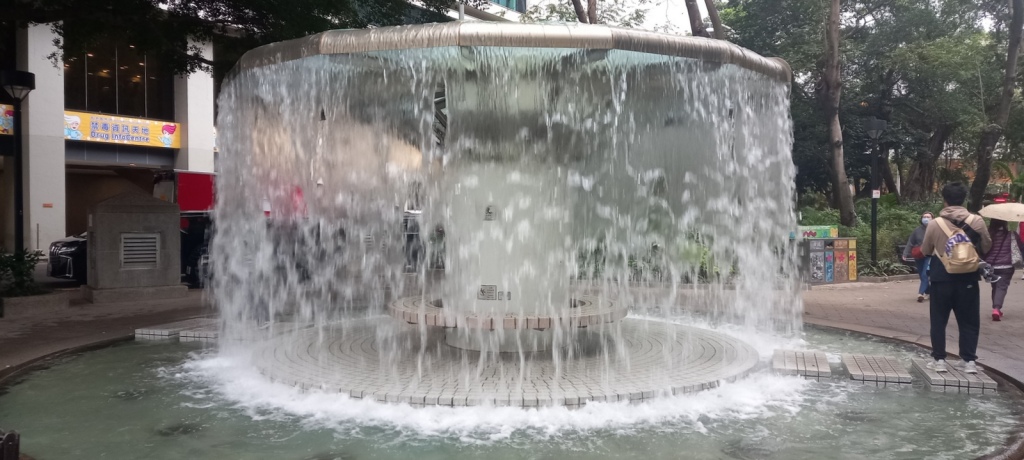
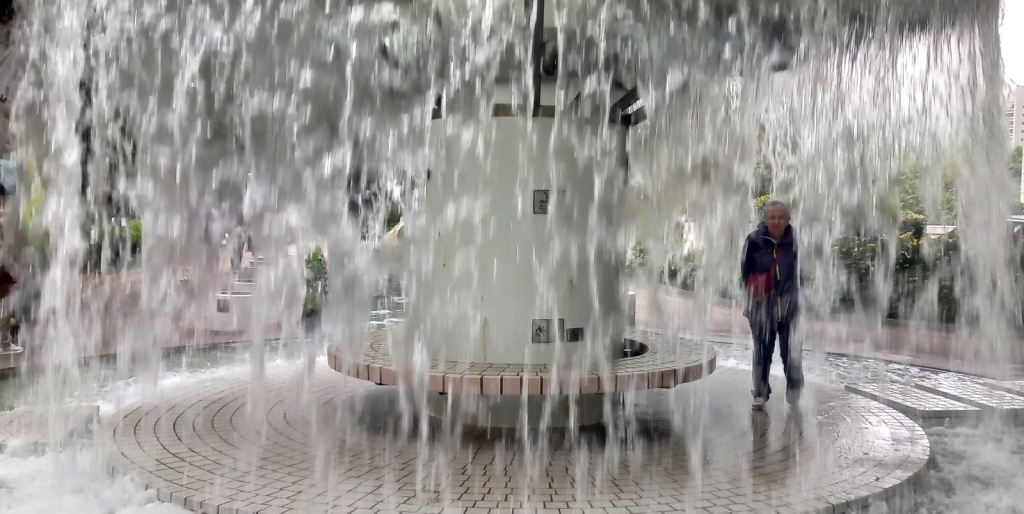
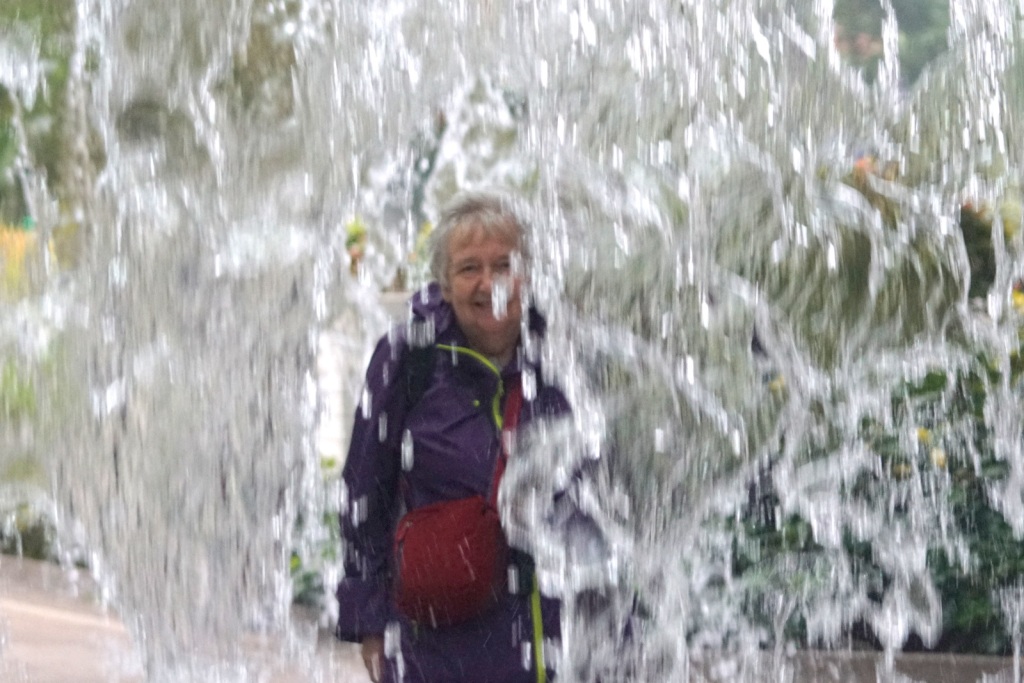
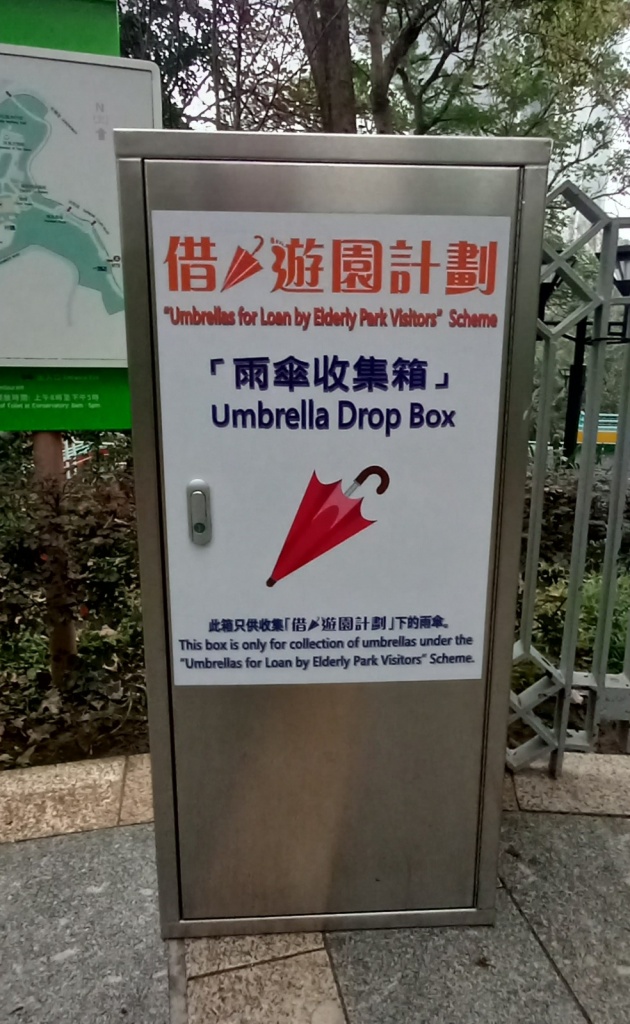
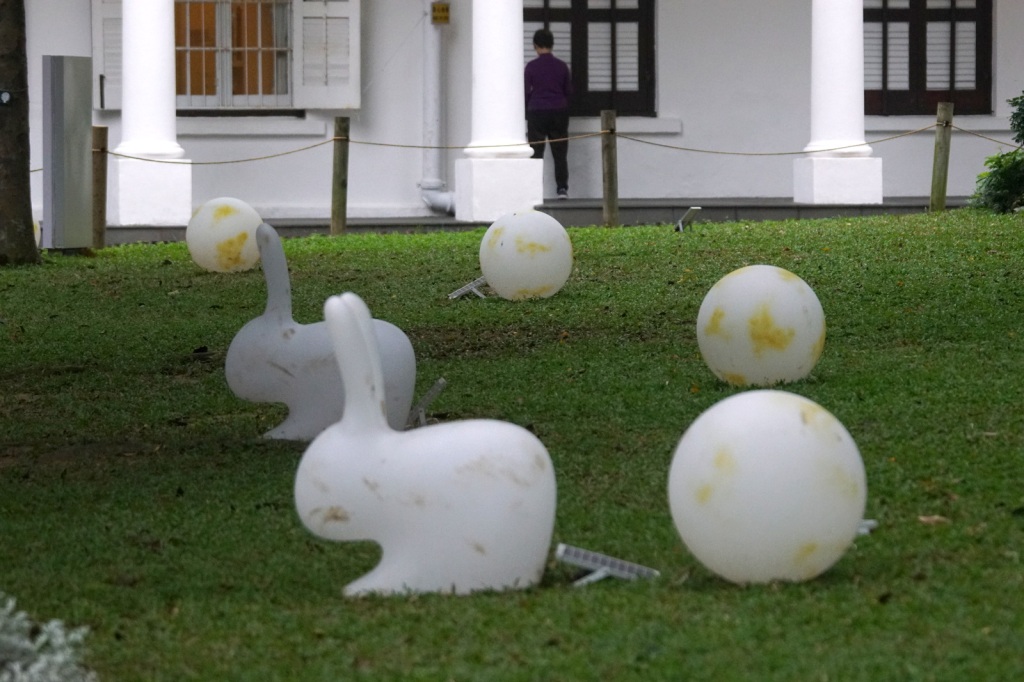
We decided to head back using the MTR rail system, as we were going to have to use it the next day and it was starting to rain. Using Google Maps to get to Admiralty Station was, however, of limited value. The underground stations had several entrances and exits and a 2D map is of limited value in 3D Hong Kong, which operates at several levels. We were directed into a mall, but it was not clear how to get out and on which level! We decided to get something to eat and dived into the first restaurant we saw, which happened to be an Italian (I don’t know why we were surprised, it’s not as if we would be surprised to find Italian or Cantonese restaurants in Britain!).
Our route to the station took us through mall hell. I’m not sure if it was one mall or many – they just seemed never ending and most of them had not open atrium areas to allow you to work out where you were and at what level, or long straight corridors. These malls were, I suspect, deliberately designed to keep you in until, in sheer desperation, you bought something. It was not as if there was much to buy. There were few sensible, practical shops, but lots of expensive jewellery and watches and designer brands like Gucci and Dior, stylishly sparse in their contents, proud of the fact that their goods are so expensive that they can leave big empty spaces in their shops. Hong Kong had become the shopping destination of choice for rich Chinese but, recently, some of these exclusive companies have been allowed to open outlets in Mainland China, and so Hong Kong is now stuck with lots of expensive shops with very few customers.
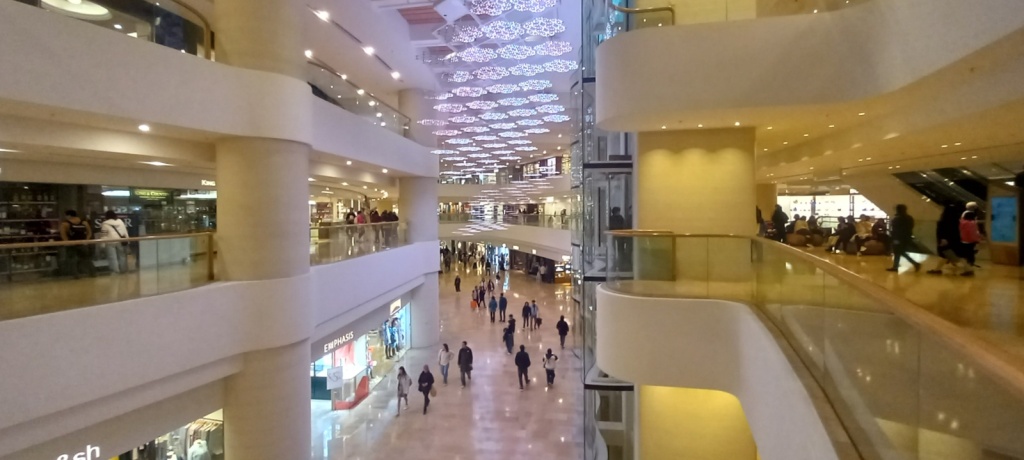
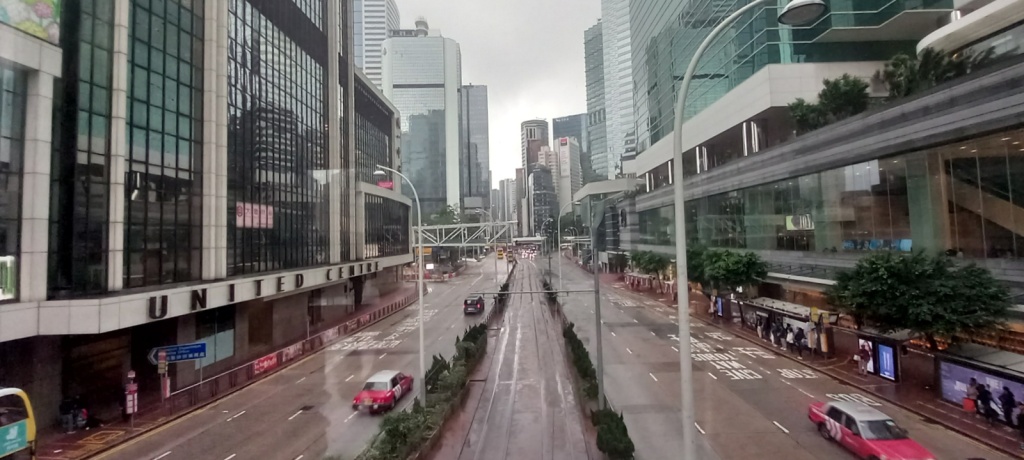
We finally found the railway station and took the short journey under Hong Kong Harbour. Easy, contactless, tap in and tap off, from Admiralty to Tsim Sha Shui. Then we had to find our way out and work out where we were! We ended up on Nathan Street, one of the main shopping streets, and having given up on finding a Hong Kong alternative, we went to Marks & Spencer. Some of the things noticeably absent from the streets, at least in the places we got to, were markets and street vendors. We were told that street food outlets had been deliberately removed by the authorities, only for them to belatedly realise later that they were not only widely used by the locals, but one of the attractions for tourists.
It was still raining, so it was time to navigate back to the cruise terminal. This meant entering the mall maze again, but we got to some of the places we recognised from the morning. We decided it would be nice to have a genuine Chinese/Cantonese meal but struggled to find a suitable restaurant. There were Japanese and western style restaurants, but the only Chinese ones we found initially were not yet open.
While we were looking for a restaurant, we were approached by a couple who asked if we were English (Margaret resisted saying no, we are Scottish, as she could see they were slightly agitated). When we replied he asked, “how the hell do you get out of here?”. Welcome to the Hong Kong Mall Maze.
Eventually, we found a Chinese restaurant that was open, at the far end of the mall, overlooking the water. A Black-crowned Night Heron flew past as we awaited our meal. We had the best, stickiest, richest Kung Po Chicken I have ever tasted and some pretty fine Pekin Duck, washed down with gallons of green tea and some Tsingtao beer.
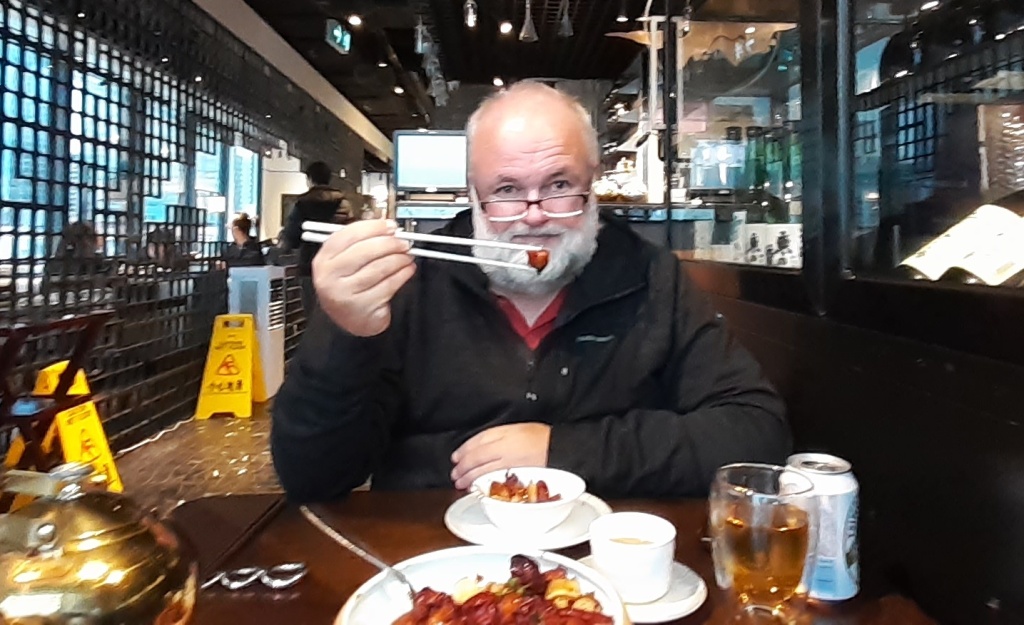

In the evening, Arcadia was perfectly positioned to watch the evening laser show beamed from the tops of buildings in Hong Kong Island, but it was a little underwhelming. We were too far from the music and the app wouldn’t download, so we couldn’t download, and the low cloud meant some of the lasers just disappeared into the mist.
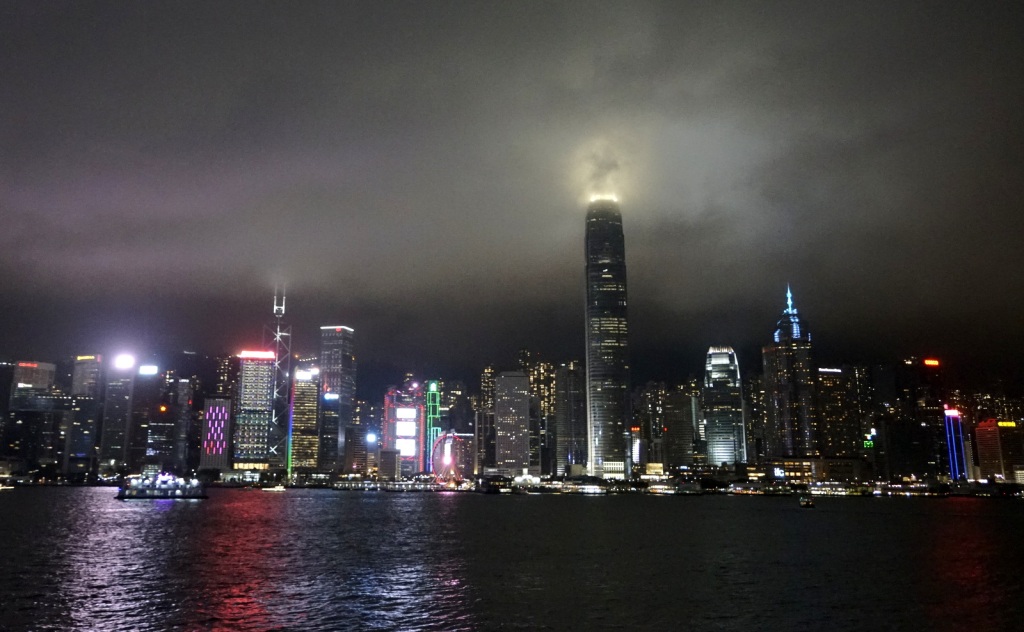
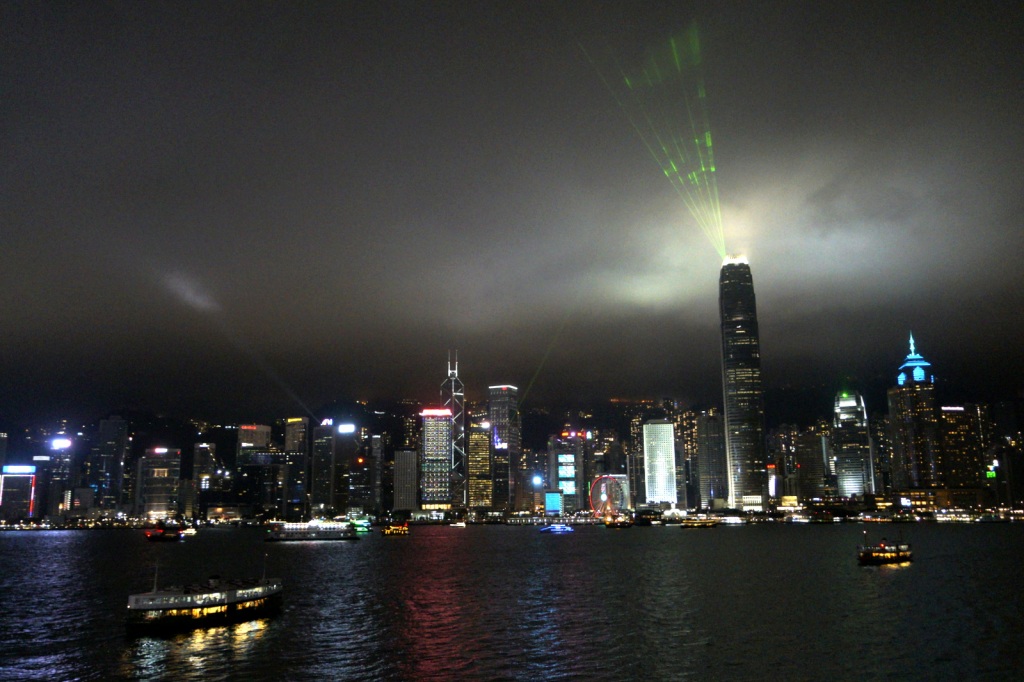

The next day, Monday 11th March, we had a guide, John from Walk Hong Kong. Due to the difficulty of driving in downtown Kowloon he had arranged to meet us at Kam Sheung Road MTR station in the New Territories at nine. We left in plenty of time, listening to an Asian Koel calling in virtually the only tree just outside the cruise terminal mall maze.
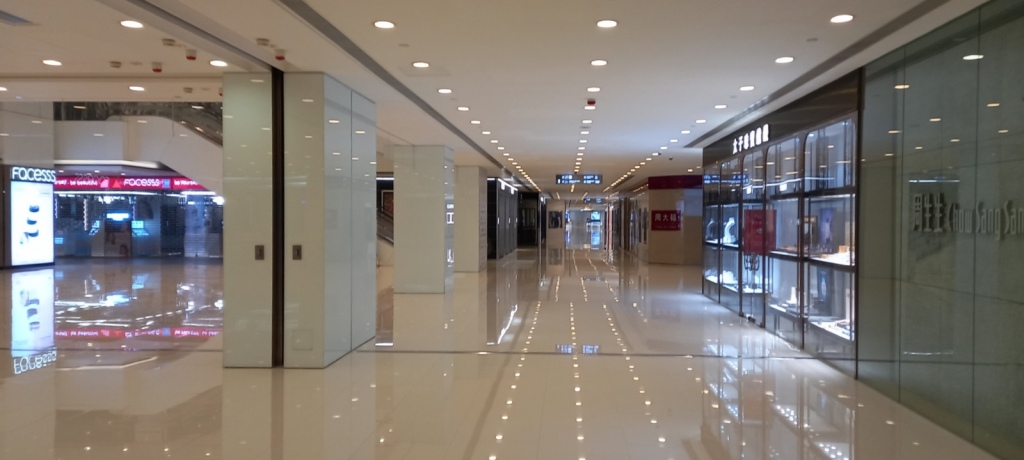
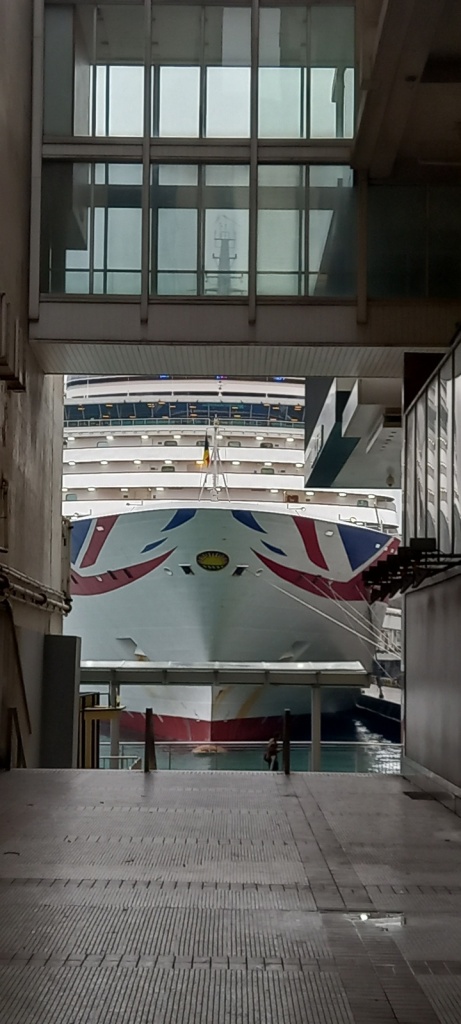
We needed East Tsim Sha Shui station, which we had worked out was entered via the same warren of underground walkways and tunnels as its near namesake, but which is on a different line.
Reaching the gates, I tapped my card and nothing happened. We tried a few times until, eventually, a friendly English-speaking Hong Kong-er told us that contactless wouldn’t work and we needed to buy a ticket. Contactless was only introduced on the system late last year, and presumably all the lines haven’t been upgraded yet. Then, the ticket machine wouldn’t take the large notes, which were all we had, so I had to go to a shop for change.
Fortunately, we had plenty of time. The rail system is incredibly efficient and there were trains every few minutes. The only real problem was making sure you were going in the right direction once you got on the platform, but there were plenty of maps so you could check the name of the terminal station. There were glass doors on the platform so no-one could access the track before a train arrived. Once on board, there were displays which showed you clearly which station you were at, where you were going, which side the doors would open – everything you needed to know. There were not many seats – most people stood – and the only surprise was that no-one offered seats to the elderly (I finally admit it, that includes us). Any seat vacated was immediately occupied by the quickest and often youngest person, who then avoided any incriminatory glances by staring intently at their phone. Although one person was, quaintly, reading an actual book written in Chinese characters.

The last section of the journey was overground and we arrived about 15 minutes early. John was already waiting for us and escorted us to his ‘elderly’ Suzuki 4WD. John had been in Hong Kong for 40 years, arriving to spend a couple of years in the police and ending up marrying one of the locals.
Today, we were visiting Mai Po. I have wanted to visit the site for years and, while I admit my birding horizons have expanded somewhat since I first read about the place, I was still really looking forward to the visit. The site is administered by WWF-HK and entry is by permit only, which have to be applied for in advance. You need to prove you are a serious ornithologist by providing proof of membership of a birding organisation – so the RSPB membership cards came in useful.
Permits are picked up from the new visitor centre. We had to pay for them and leave a deposit to make sure we brought them back. Once we had the permits, we had that strange African/Asian experience of taking them elsewhere to be validated, which meant a short stroll to the warden’s office.
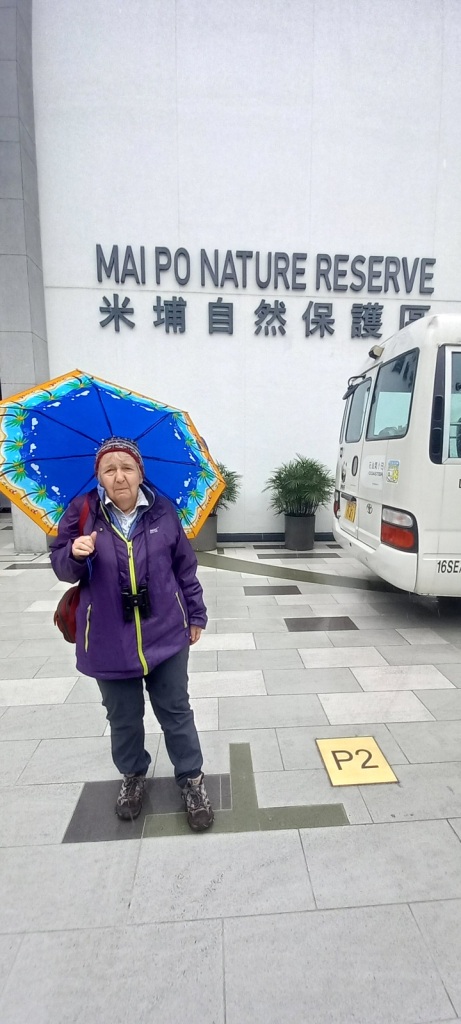
There were a few House Swifts amongst the Barn Swallows flying around this area. A couple of Asian Koels were calling and showing well outside the visitor centre. Two Eurasian Collared Doves outside the warden’s office surprised me, but we saw several during the day; they have apparently arrived here naturally. The first Chinese Pond Heron of the day was also here.
Small birds along the walk to the warden’s office included the first Pale Prinias of the day and a couple of Masked Laughingthrushes. Two Siberian migrants which we often see in Shetland were also here, but I was ridiculously pleased to see them: the first of three Dusky Warblers and a Little Bunting. Eastern Yellow Wagtails (of the race taivana), and Amur Wagtails (leucopsis race of White Wagtail) were also seen frequently during the day, while we had one East Siberian White Wagtail (ocularis White Wagtail) here and a few more later in the day. We also saw the first of several White-throated Kingfishers.
At this stage, the sun was almost breaking out. We passed a noisy group of students on an educational visit. The guide was using a microphone and speaker to make herself heard. They all had binoculars but only a few of them were using them.
We returned to John’s car and drove out to the beginning of the boardwalk. We drove alongside the barbed wire-topped border fence. This doesn’t mark the actual border, which is in the middle of the river, but is along the first dry land after the mangroves. It isn’t patrolled like it was in the past, but it is still well-maintained. To get to the boardwalk meant passing through a gate in the fence. The gate still has CCTV on it and, a little further on, there was a camera trap strapped to the boardwalk, which I don’t think was for monitoring wildlife!
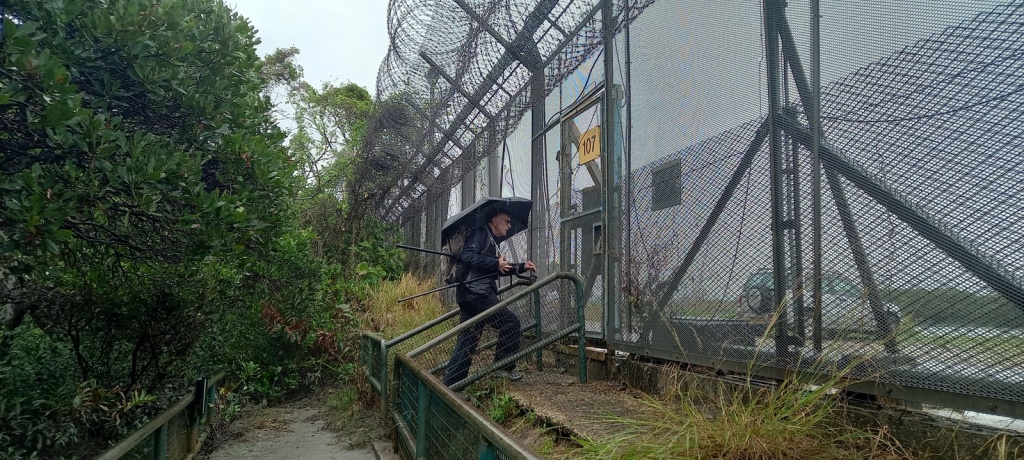
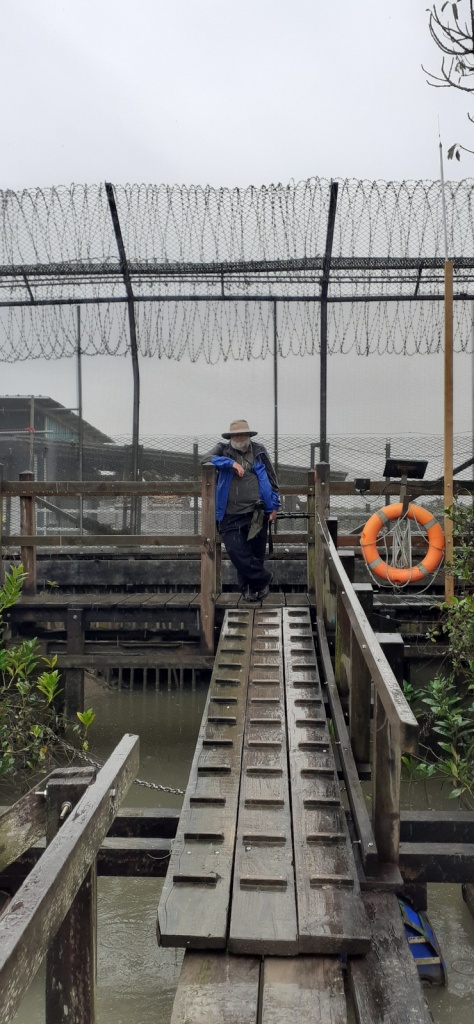
I have often heard of the Mai Po boardwalk and, in my mind’s eye, it was a conventional wooden boardwalk over some saltmarsh. But, of course, this is southern Asia, so there are mangroves. The boardwalk here consisted of two wooden planks, and a handrail on one side, all connected to empty wooden drums so it would float if the mangroves were flooded.
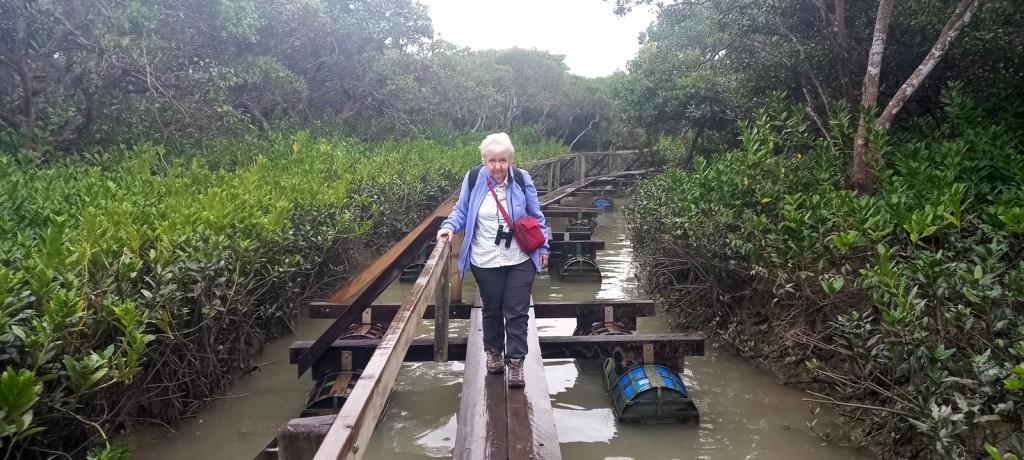
The boardwalks took you out to some hides on the edge of the mangroves and overlooking the mudflats. I was relieved to see that they were proper hides, with a roof, as it was now raining quite heavily. It would continue to rain on and off for most of the rest of the day. the mangroves held very few birds. We heard Swinhoe’s White-eye and Masked Laughingthrush but this part of the world has no mangrove specialists, like many places do. I wonder why?
The hides overlook mudflats, which you might describe as the shallow part of Deep Bay. The tide was already rising and there were already hordes of birds in front of the tide. Admittedly, many were familiar species – Black-headed Gull and Avocet were the two commonest species – and Margaret did say it felt a bit like sitting in the hides at somewhere like the RSPB reserve Leighton Moss at time – but, to me at least, there is something quite fascinating about looking through familiar birds in the knowledge that something unfamiliar could pop up at any moment. Occasionally, the skyscrapers of Shenzhen in Mainland China loomed out of the mist.

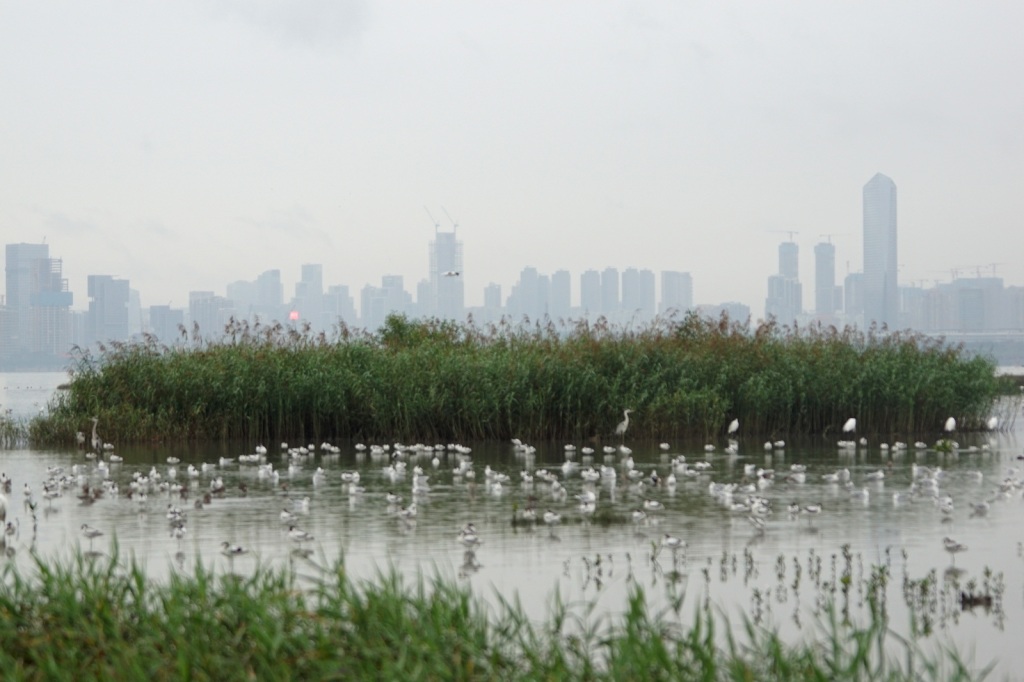


The star bird was Saunder’s Gull, with at least eight summer plumaged adults in amongst the Black-headed Gulls. Too far away to photograph, but some excellent scope view. There also about 40-50 ‘large white-headed gulls’, as birders call them, the now many and various species which were once nearly all Herring Gulls. Most of the adults, and some of the juveniles, were, as far as I could see, Heuglin’s Gull, currently classified as the High Arctic race of Lesser Black-backed Gull. There were also a few juveniles which are now thought to be Vega Gulls, currently classified as a separate species from Herring Gull (although John remembers the day when suggesting they were Vega Gulls would be scoffed at, and one of my field guides suggested they were Caspian Gull). There was also one bigger, paler and very stout-billed juvenile which was a Slaty-backed Gull.

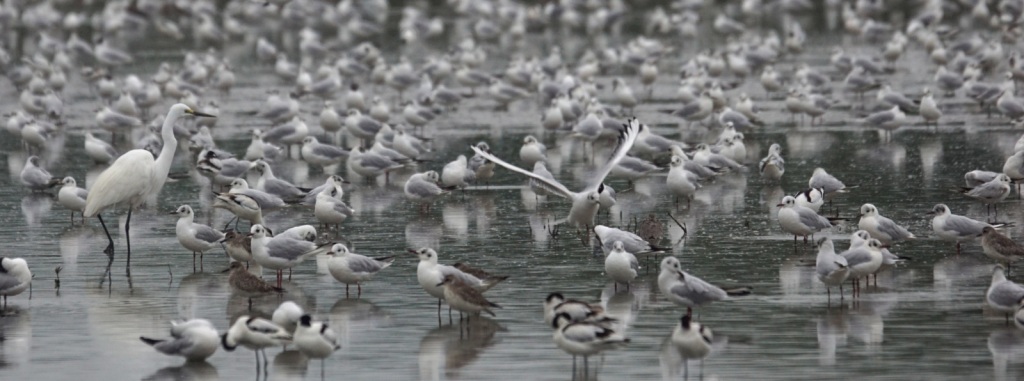
Other than Avocets, the waders included lots of Dunlin, Eurasian Curlews and Grey Plovers, and a few Redshanks and Black-tailed Godwits (of the race bohai which breeds only in China). A lone Far Eastern Curlew was keeping itself to itself away from the other curlews and there was also one Bar-tailed Godwit. John saw some distant Great Knot but I never got round to looking at them – partly assuming they would get closer as the tide rose. Both wader and gull passage could get much more exciting later in the spring.
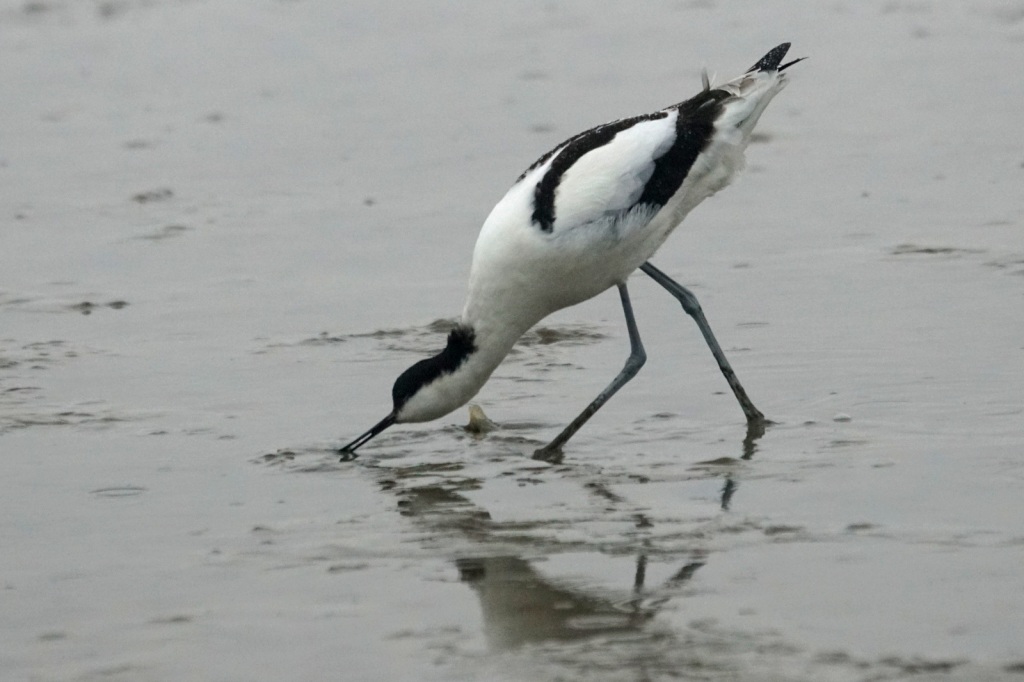
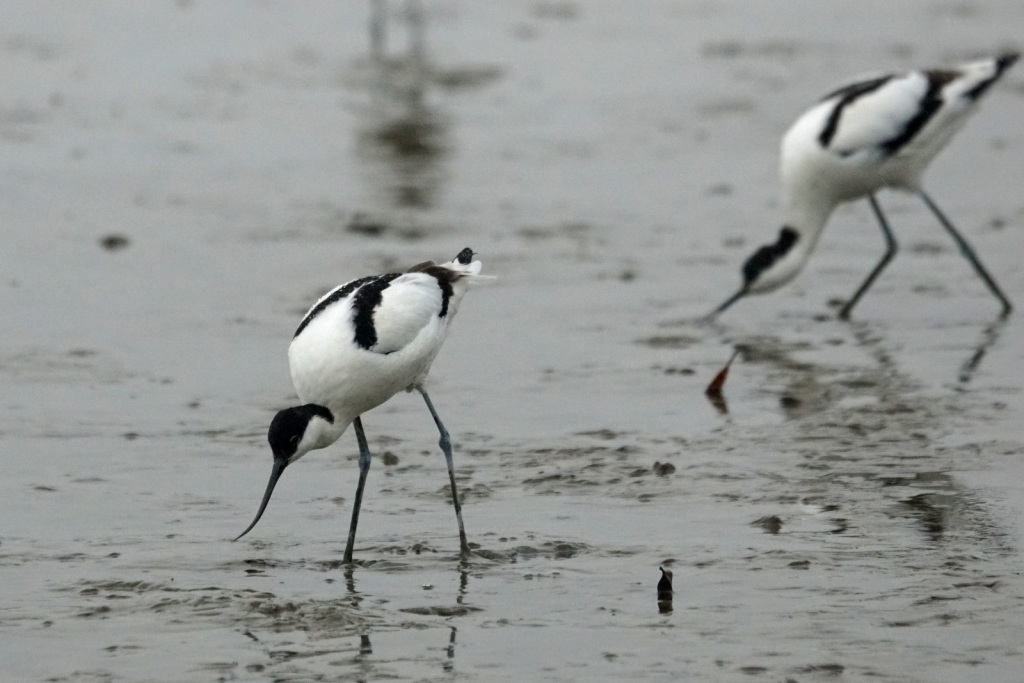
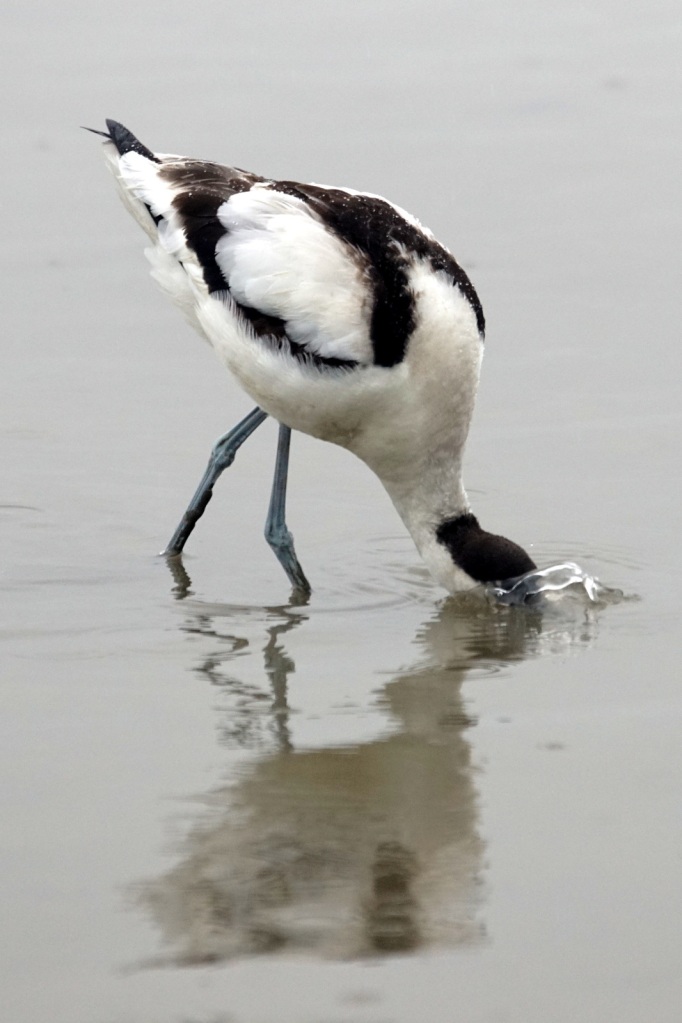
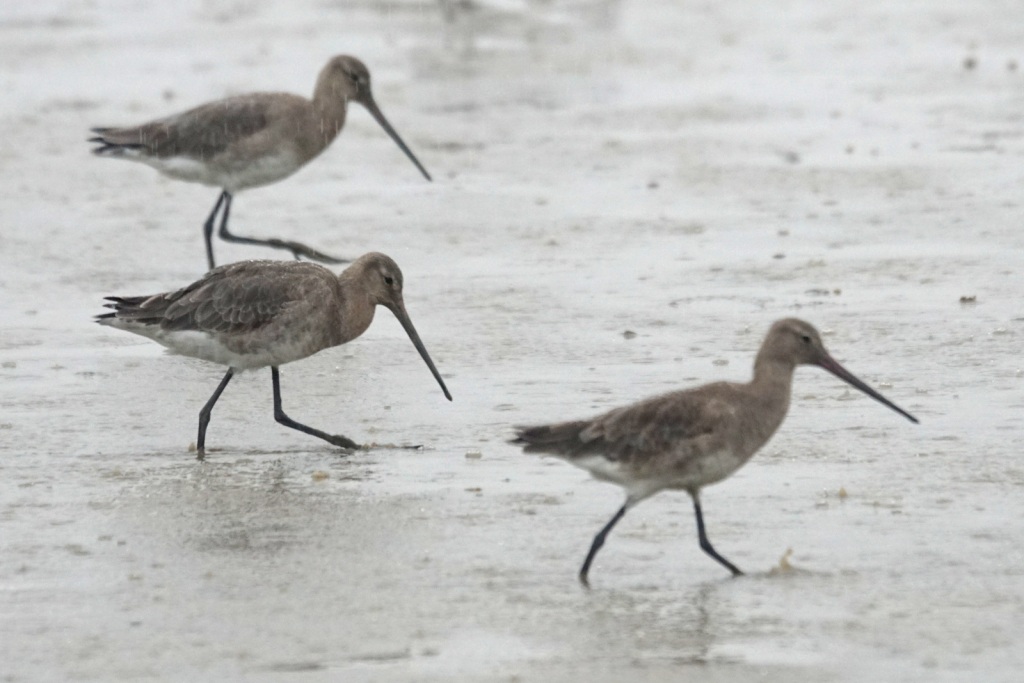
About 15 Black-faced Spoonbills were here and another bird which had a face like Eurasian Spoonbill, but which was the same size as the Black-faced; John had seen it the day before with another Hong Kong birder and they had concluded that it could be a hybrid. There were also lots of Grey Herons, Great Egrets and Little Egrets and three Medium Egrets (as Intermediate Egret is now known here, since the three-way split of the species). A few ducks here included some Pintail.
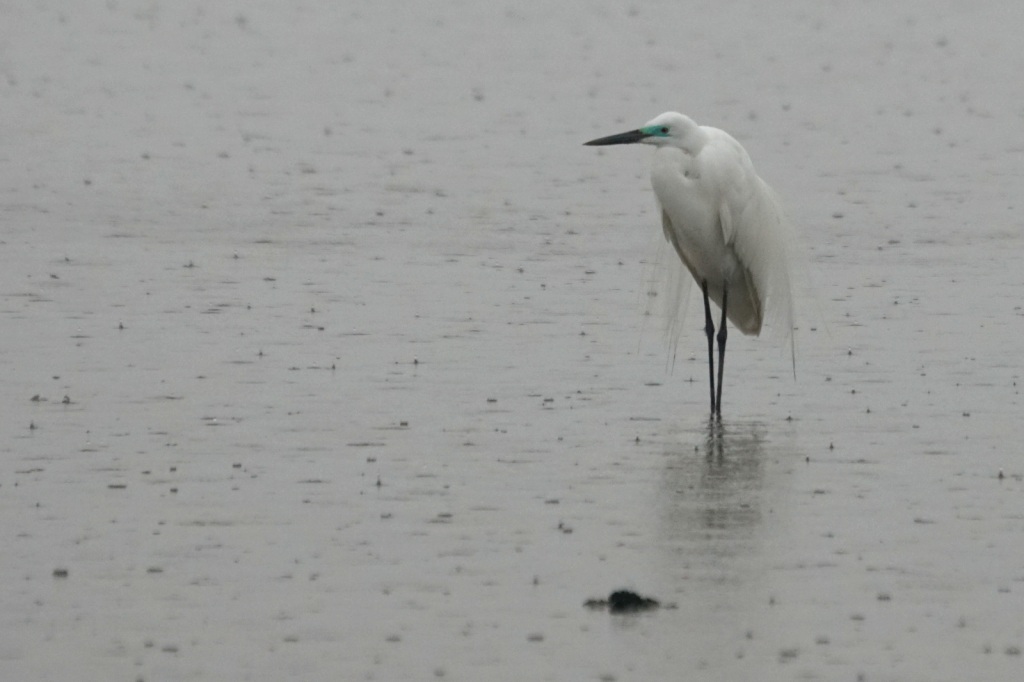

Once it was clear that the tide was not going to rise any further, we returned along the boardwalk and back to John’s car. We then checked some of the mainly freshwater pools. These were formerly used for rearing prawns, but are now managed as a nature reserve, with water levels controlled for the benefit of birds. Most are full, but the water-levels on some are lowered and many birds come here to continue feeding or to roost over high tide.
The pools had many ducks, mainly Wigeon and Shoveler, but with a few Eurasian Teal Tufted Ducks, and some other waterbirds, including a few Little Grebes, four Coot and a Moorhen. I asked about more exotic ducks, like Falcated Duck, but John said that this was one species, another being Shelduck, that just did not seem to come this far south anymore.
The freshwater pools had a greater variety of waders. As well as some of the species we had seen earlier roosting there, we also saw Marsh Sandpipers, and a few Wood Sandpipers, Green Sandpipers and Common Sandpipers. There were some Little Ringed Plovers and Kentish Plovers on the pool with the lowered water-levels, along with eight Pacific Golden Plovers. Three Curlew Sandpipers were also here; they are just starting to return north, with the first ones only seen a few days ago. The first Pied Kingfisher of the day was also seen flying past the hide overlooking the wader pools.
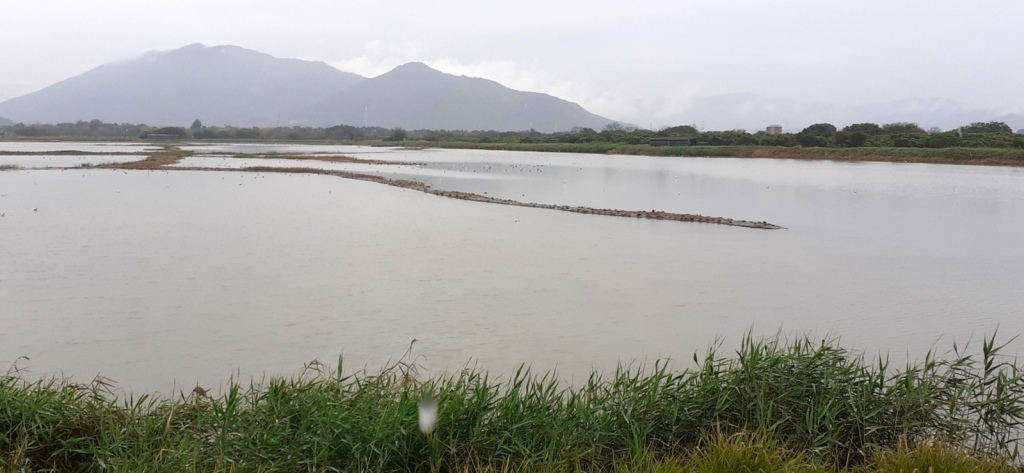
Considering the weather, we did quite well for raptors. As well as the ubiquitous Black Kites, there was an Osprey perched in one of the trees, an Eastern Marsh Harrier quartering over a reedbed and two Eastern Buzzards.
After returning our permits and recovering our deposit we stopped to check some pools on the access road. We had already checked there on the way in, seeing a couple of Great Coucals and our first Black-winged Stilts of the day, but John wanted to look for a tagged Sanderling reported here; it had gone but we saw two Common Snipe instead. Our only Collared Crow of the day flew over here. There was also a Long-tailed Shrike and an Oriental Turtle Dove along the road, and a bit further along we saw our first White-breasted Waterhen and only Grey Wagtail of the day.
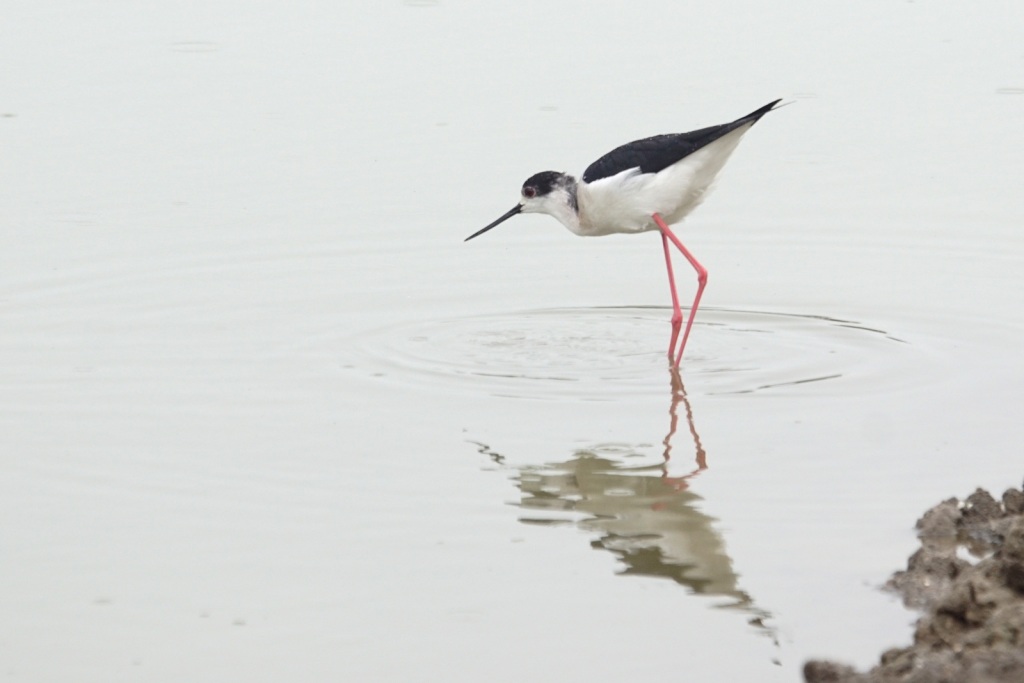
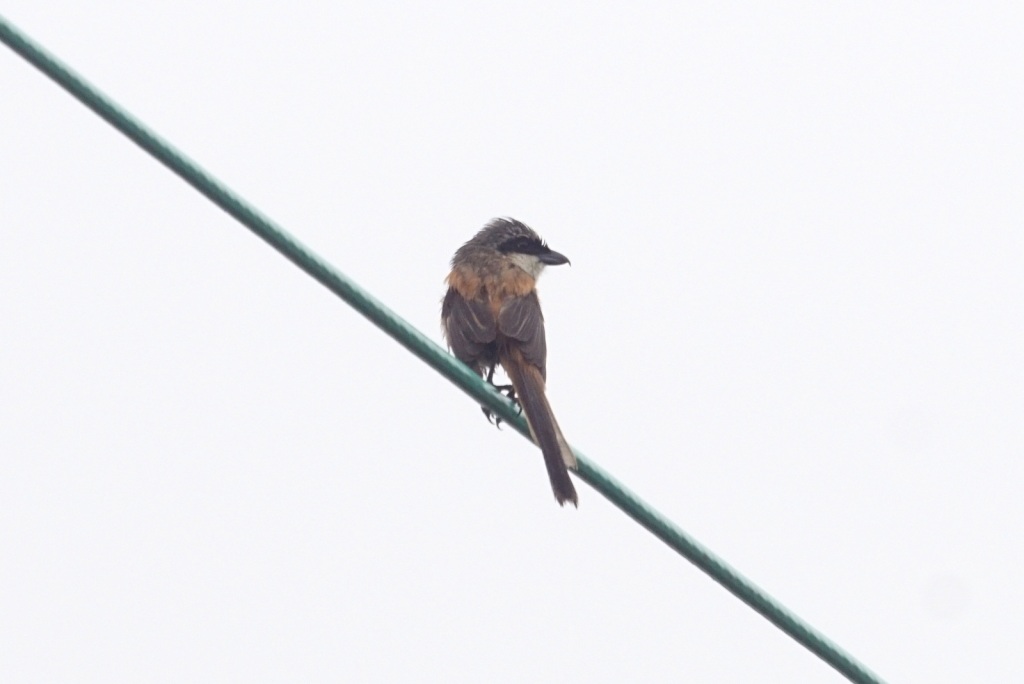
Just to the east of Mai Po, next to the village of San Tin, there are some fishponds, and we went and checked these next. They are still working fishponds although, as Margaret commented, there did not seem to be any people there, but John pointed out that it was raining. Some of the ponds were empty, as they have to periodically drained and all the accumulated detritus removed before the pond is relined with clay. Then, after it has been refilled with water they have to be aerated before it is restocked. Some of the ponds had nets across them, to try and stop Great Cormorants, in particular, from depleting the stock. Watching a Little Grebe diving amongst some nets I wondered out loud how they avoided them. “They don’t always,” John replied.
The main food for the fish seemed to be breadcrusts! John had said that he had wondered by most of the bread in Hong Kong had no crust and it seemed it was used to feed fish. There were plastic bags of bread crusts everywhere, occasionally some piles of breadcrusts which were attracting flocks of bird and some of the ponds were full of soggy, floating bread.


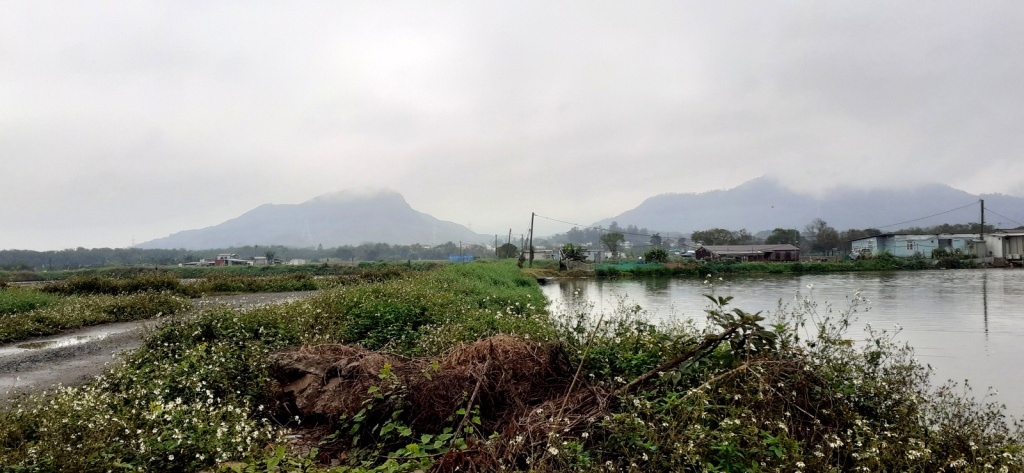
Many of the birds here were similar to those we saw earlier at Mai Po, although some (like Common Sandpiper and Black-winged Stilt) were commoner here, and others (like Avocet) were scarcer.

We had a good haul of starlings, many of them feeding on bread crusts! These included at least 20 Red-billed Starlings, 20 White-shouldered Starlings, six Black-collared Starlings and four White-cheeked Starlings. A flock of Crested Mynas included at least six yellow-billed Great Mynas, which are believed to be introduced.
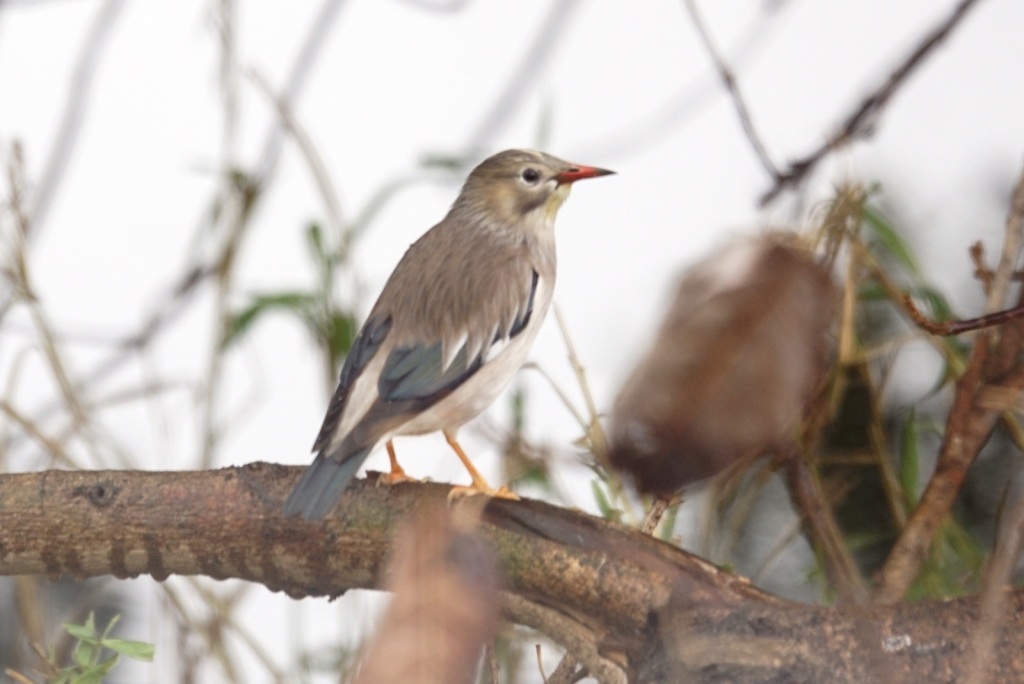
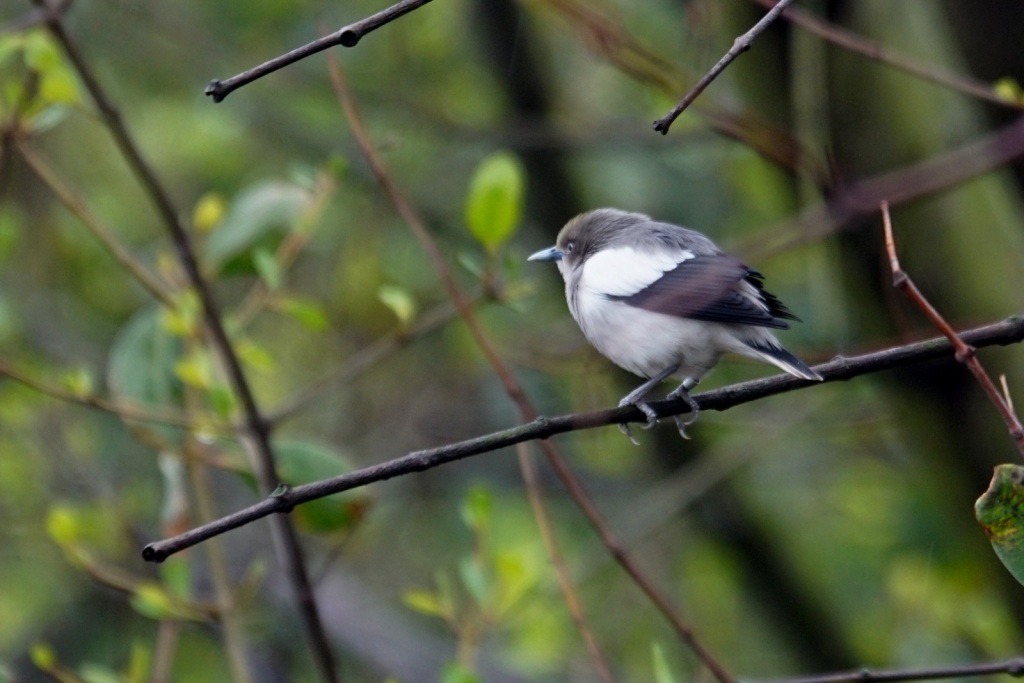
At one stage, a Daurian Jackdaw joined a feeding flock of starling on some bread, but it bore a ring and was a long-staying and well-known presumed escape. Other corvids included a pair of Azure-winged Magpies, which are introduced here, some Oriental Magpies, now split from Eurasian Magpie. There was also flock of Black Drongos.
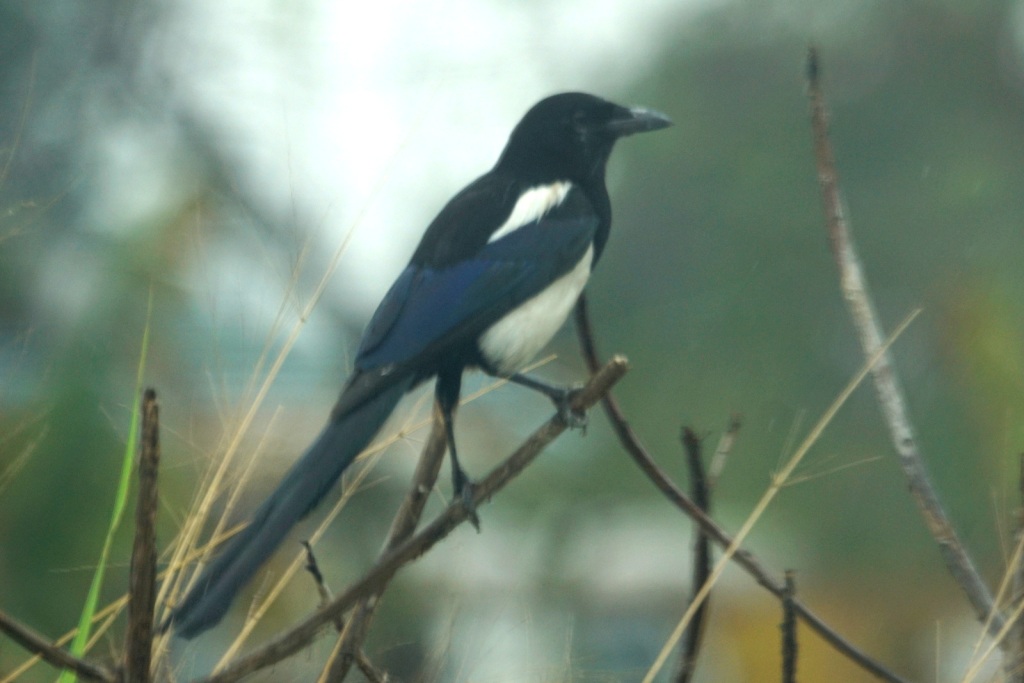
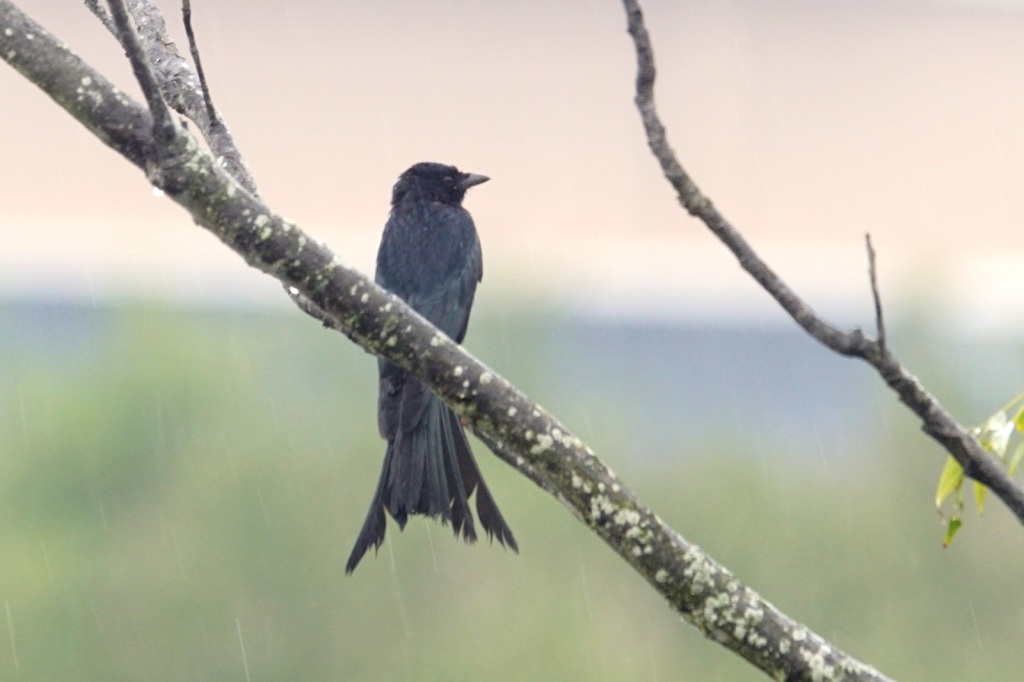
We struggled to find many pipits but towards the end of the visit we saw several Red-throated Pipits and a Richard’s Pipit.
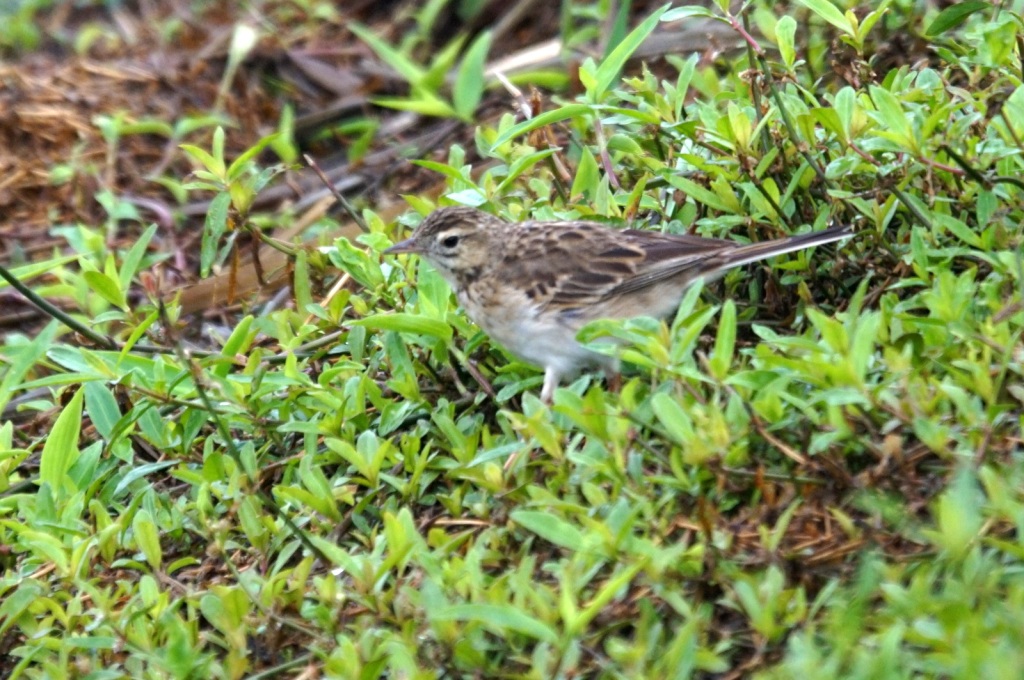
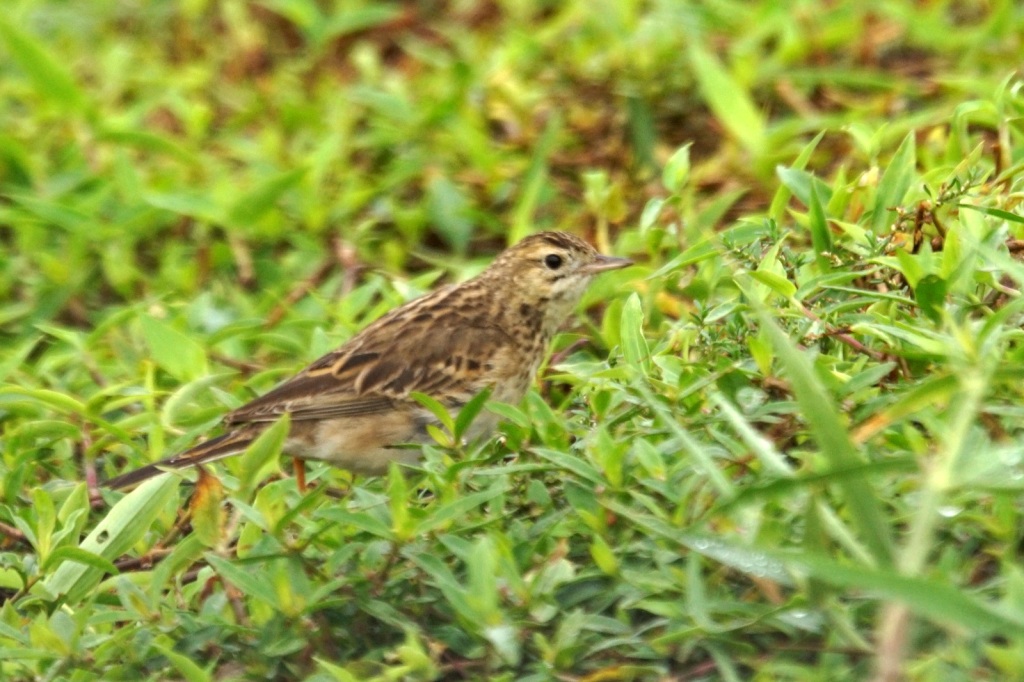
Other passerines included several Amur Stonechats, another Long-tailed Shrike and two Yellow-bellied Prinias amongst the Plain Prinias.

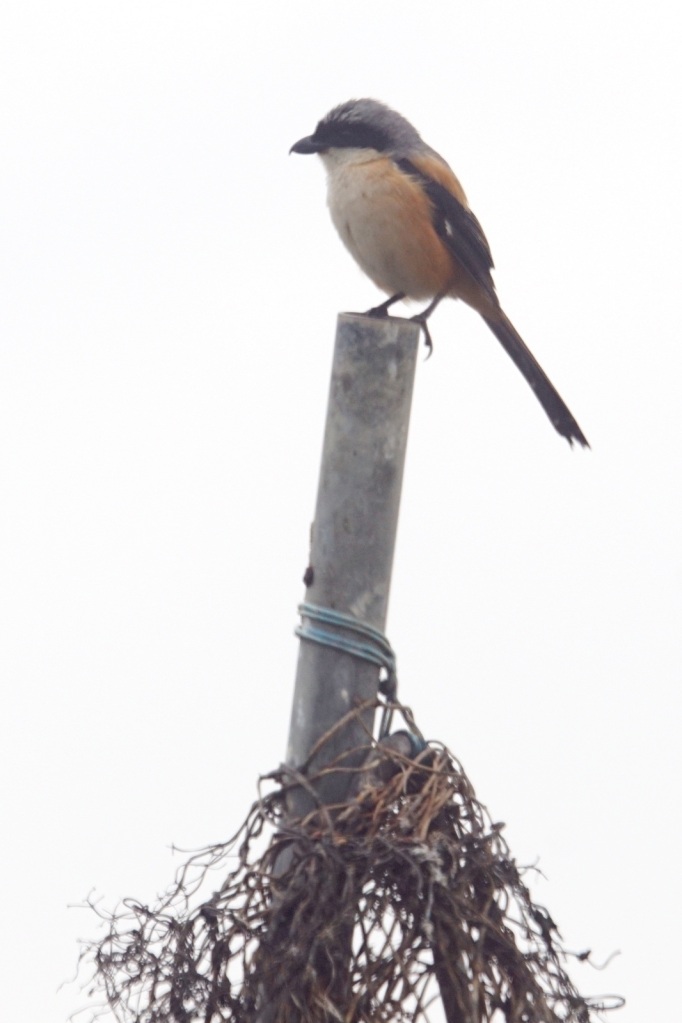
A Plaintive Cuckoo was rather perplexing at first, as I definitely haven’t got my eye for these small cuckoos. We also heard Large Hawk-cuckoo. Pigeons included a small flock of Red Collared Doves and four more Oriental Turtle Doves.
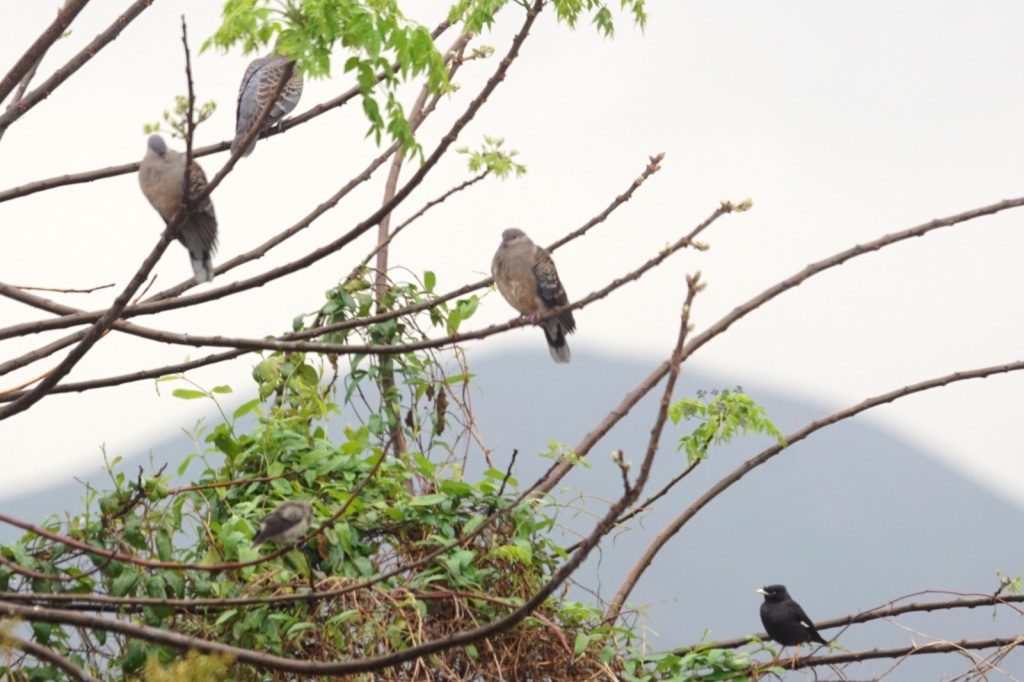
There were plenty of waders but the only new species for the day was a Grey-headed Lapwing. The only other one I have seen was a first for Britain that I twitched in Northumberland about this time last year.
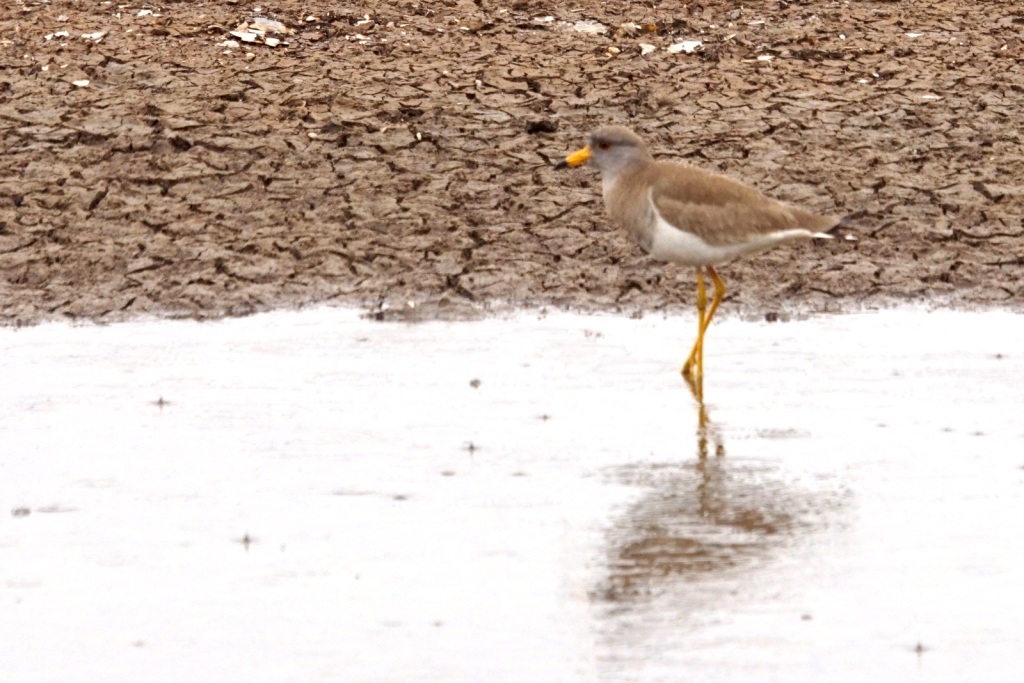
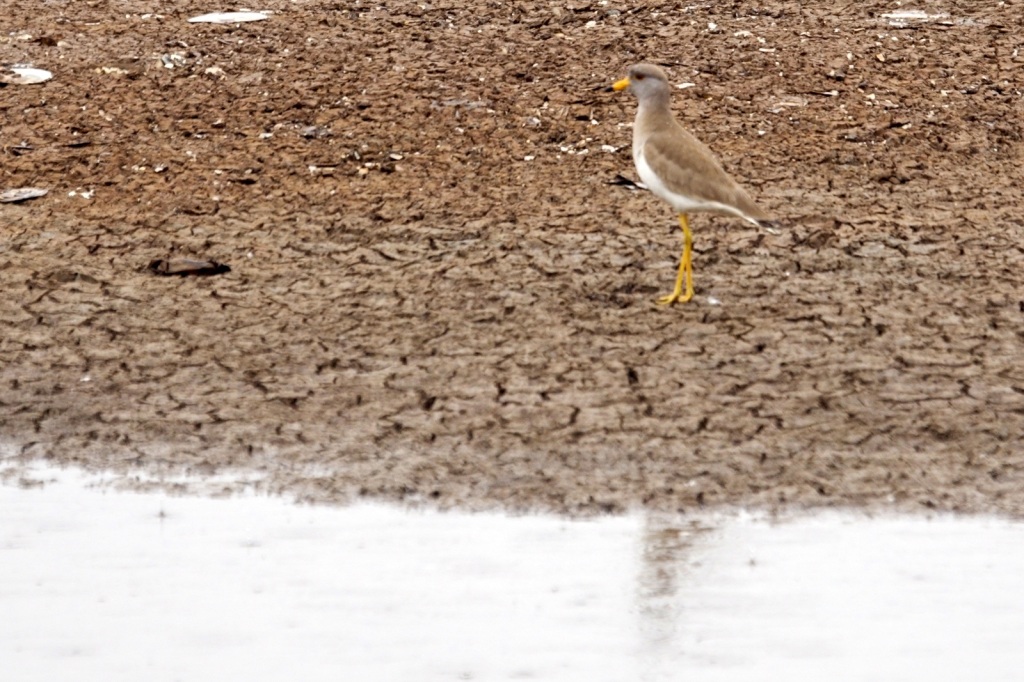
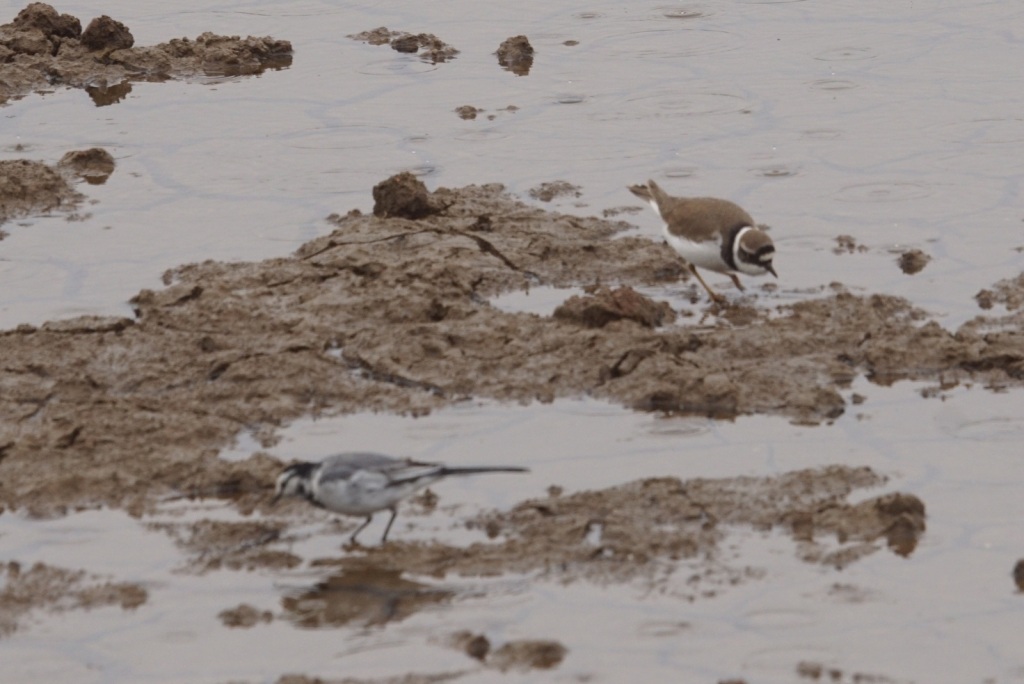
Three species of kingfisher here were Common Kingfisher, as well as Pied Kingfisher and White-throated Kingfisher which we had already seen. Other birds we had seen earlier included a flock of 20 Black-faced Spoonbills and an Eastern Buzzard.
Almost the last bird we saw was a Black-faced Bunting, a bird I possibly should have seen in Shetland, but haven’t yet.
We also tried a few more wetland sites, including some rice paddies at a village called Lok Ma Chau, where there were more Red-throated Pipits, a Red-rumped Swallow and two more Greater Coucals.
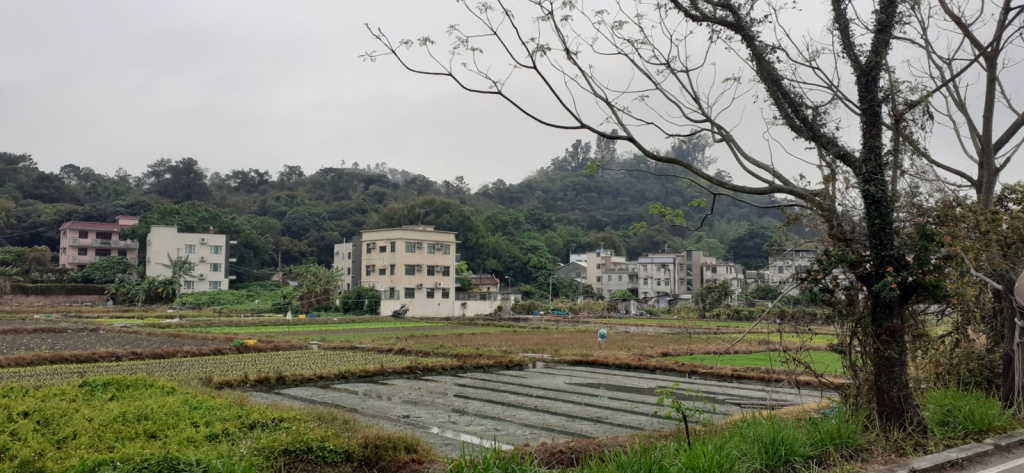

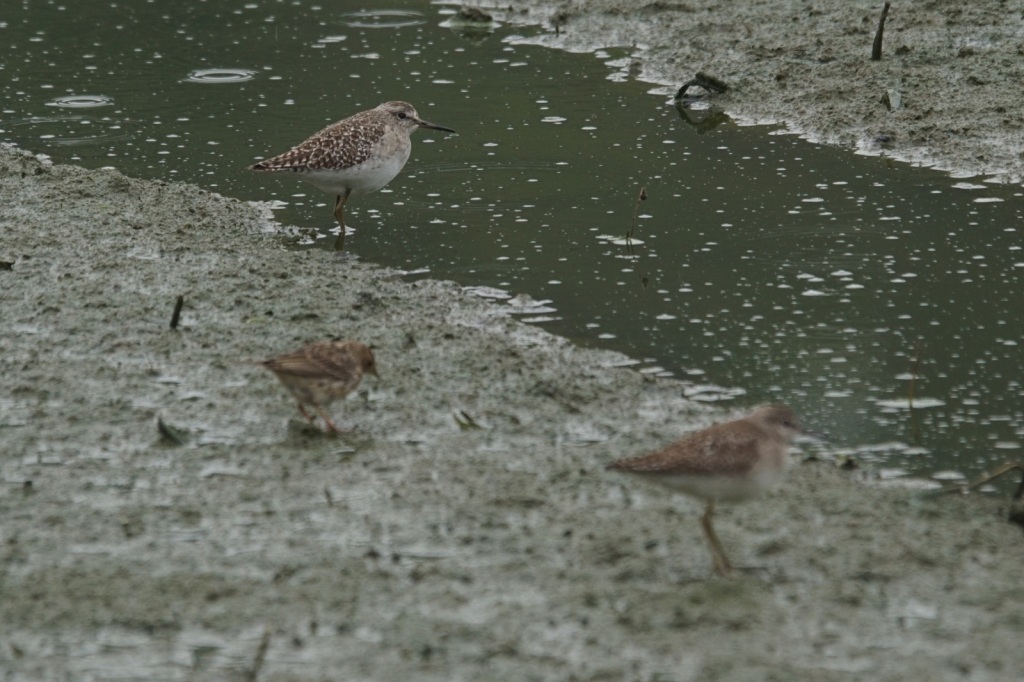
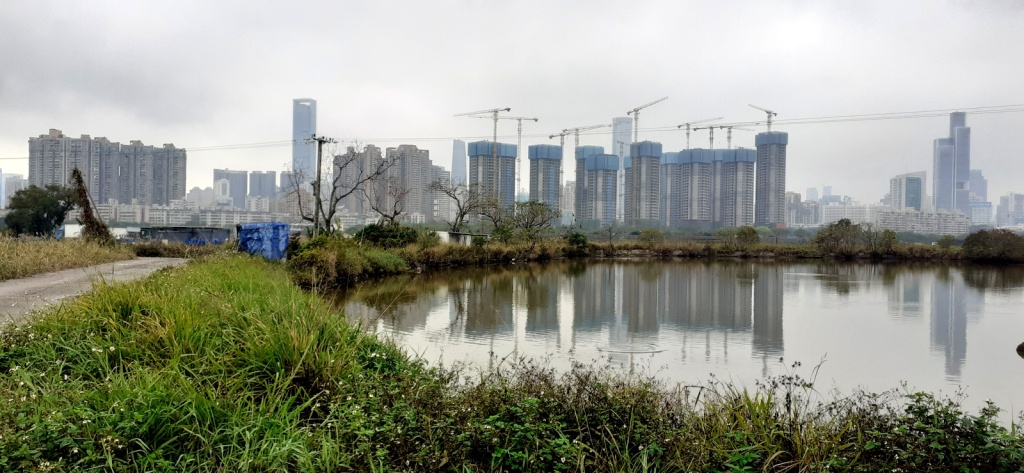
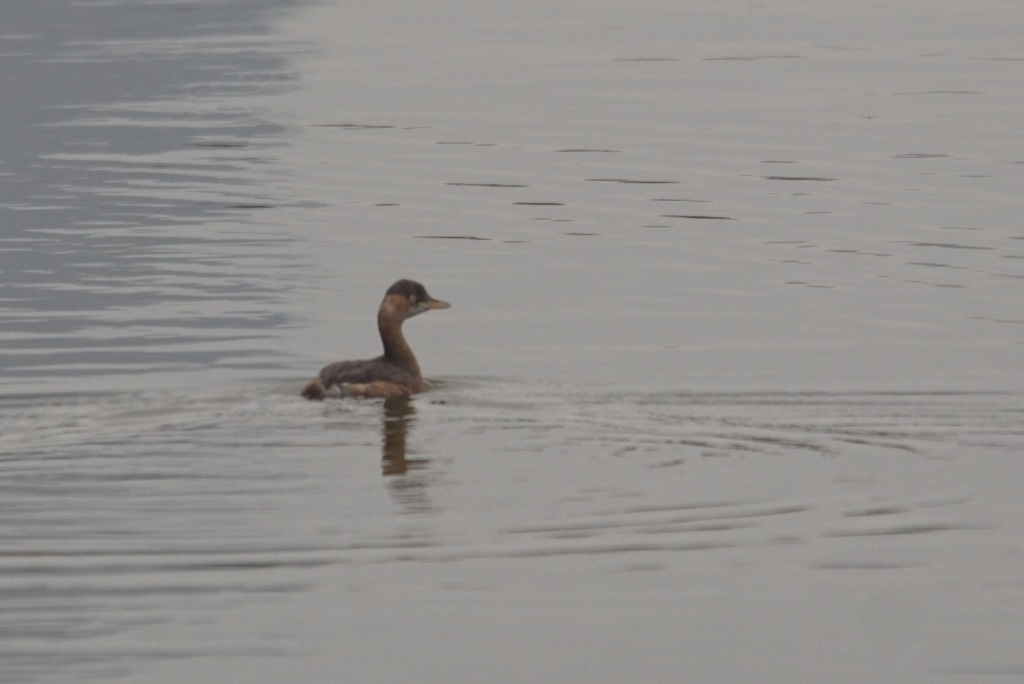
All the time, China was over the river looming over us. Looking at some Black Kites with Chinese skyscrapers in the background, Margaret asked if they could go on our China list if we saw them fly over the river. “I suppose so,” replied John, “but some would say they are all on your Chinese list,” he added, somewhat darkly.

We had time for one more stop. On the way I saw a roadside Eastern Cattle Egret. Margaret began to worry about the time, although I pointed out that my tracking app showed we were heading back to the railway station and were not still heading away from it.
We stopped for a short walk at Tai Lau Country Park, which gave us another aspect of Hong Kong. It was rather grey and overcast, although the rain had almost stopped, and John was of the opinion that the time of day and time of year were not the best for Hong Kong woodland sites, but we saw a few interesting species.

A male Grey-chinned Minivet couldn’t stop posing of the camera although a Black-winged Cuckooshrike was a little more camera shy. A pair of Fork-tailed Sunbirds gave much better views than yesterday and a Common Emerald Dove came out and showed itself. Other birds seen included a Grey-headed Canary-flycatcher, a Japanese Tit, a distant Ashy Drongo, a Yellow-browed Warbler, a flock of Swinhoe’s White-eyes and some House Swifts overhead. Birds heard included singing Silver-eared Mesia and Black-throated Laughingthrush.
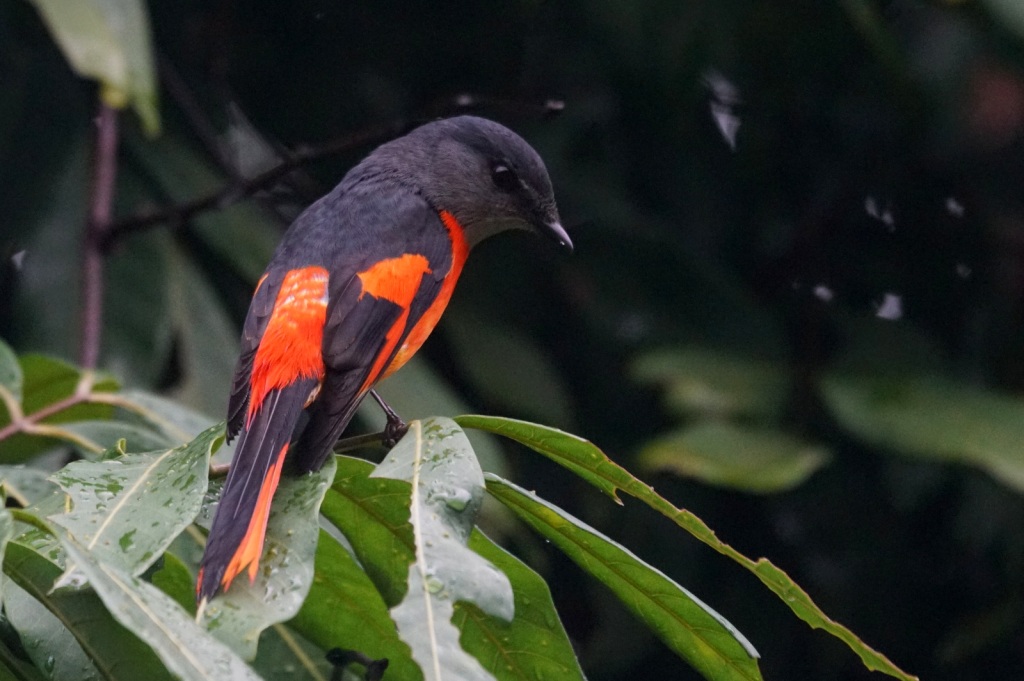

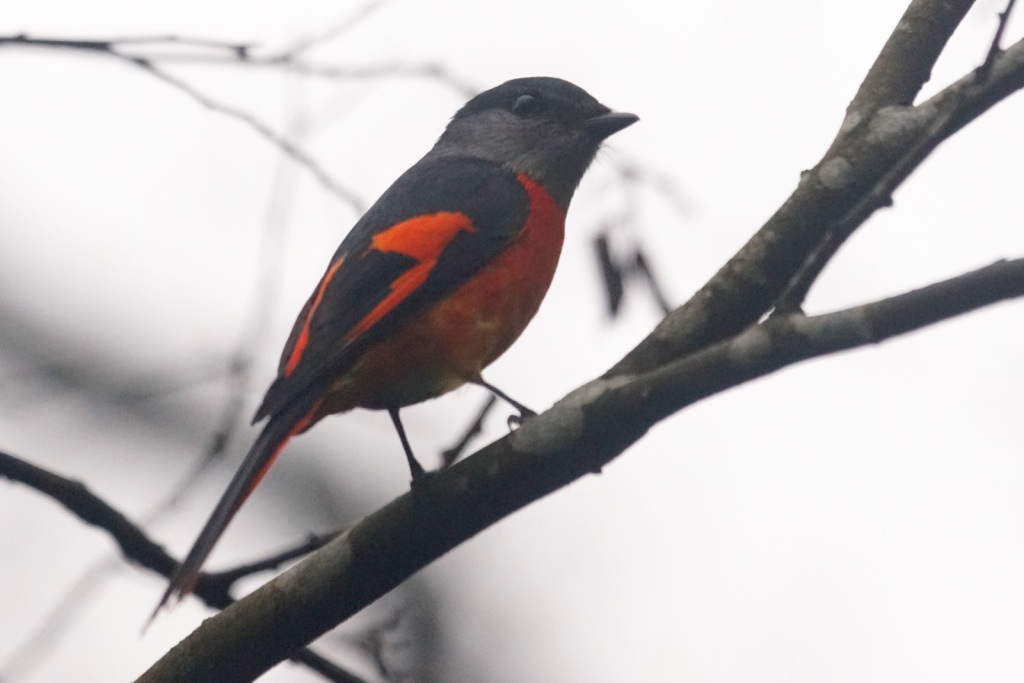
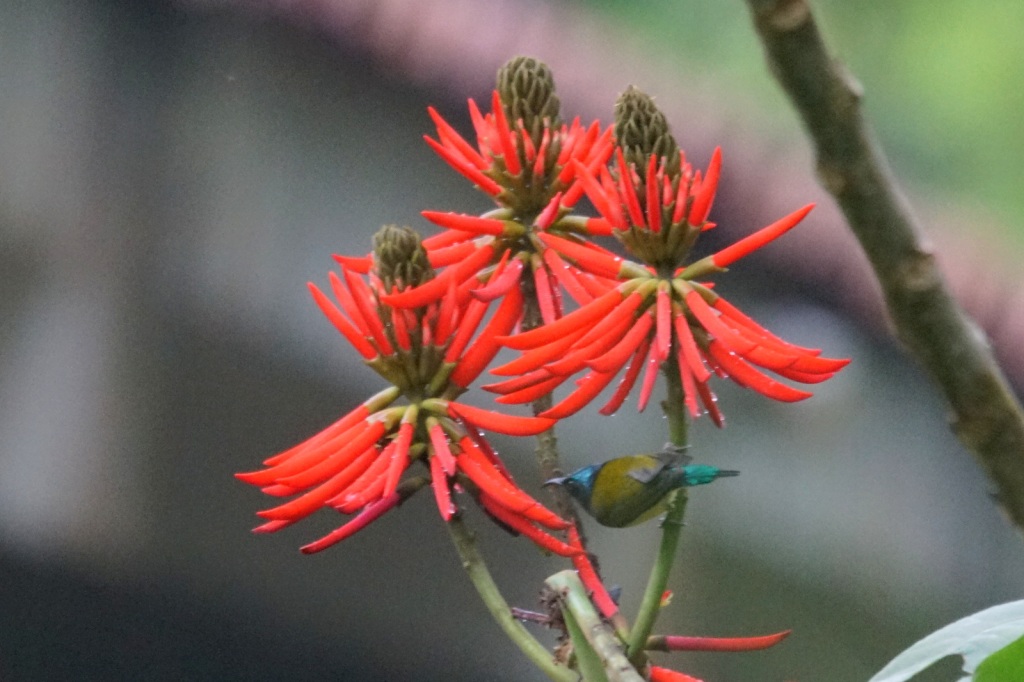
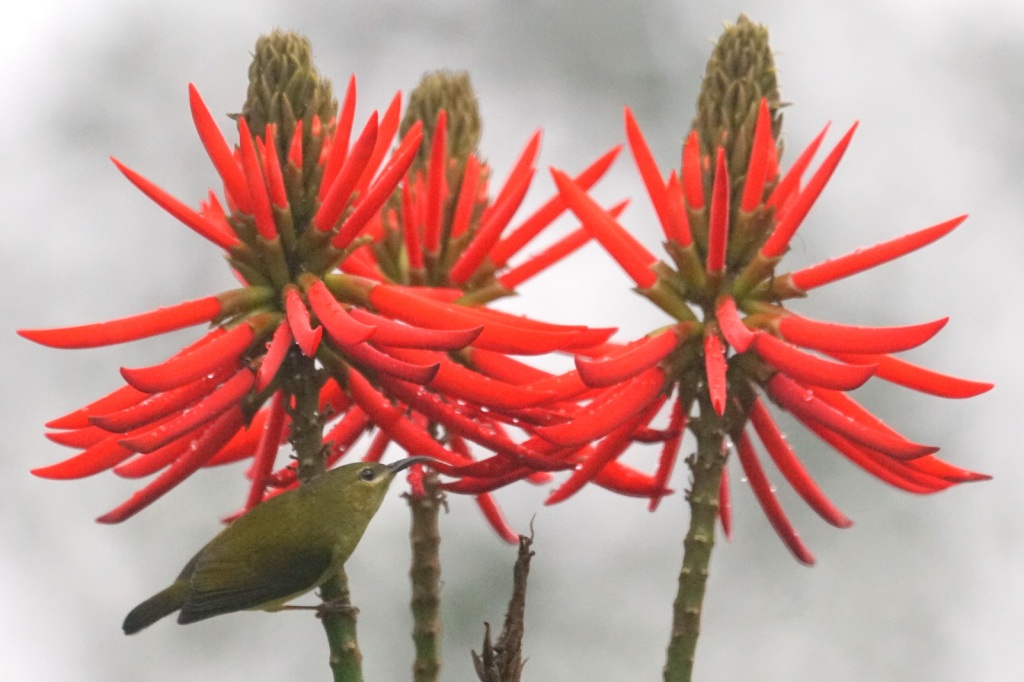
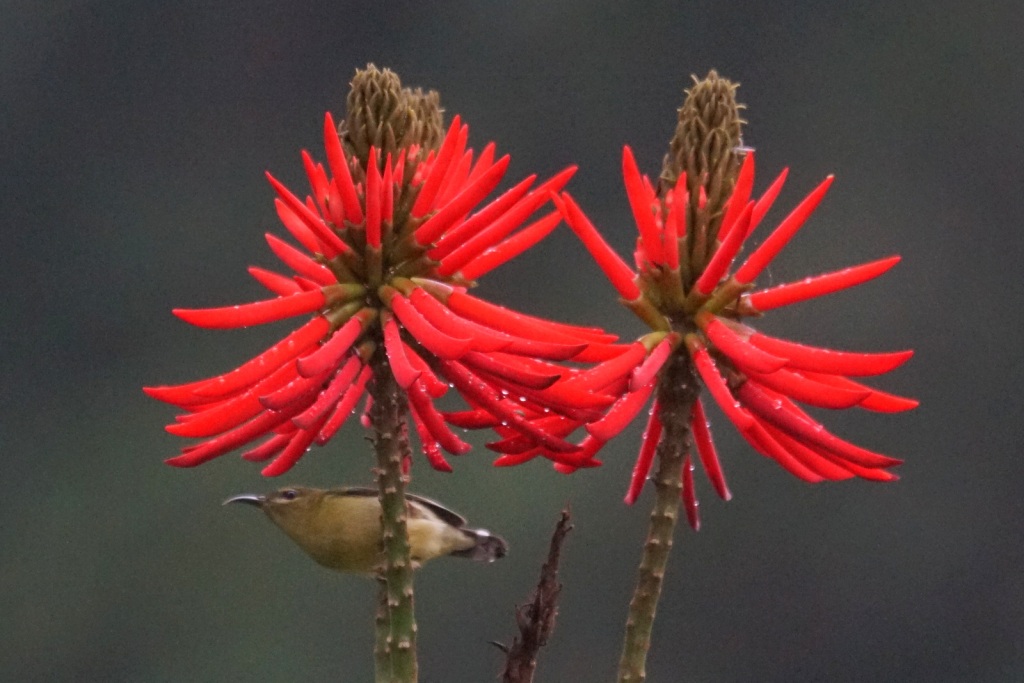
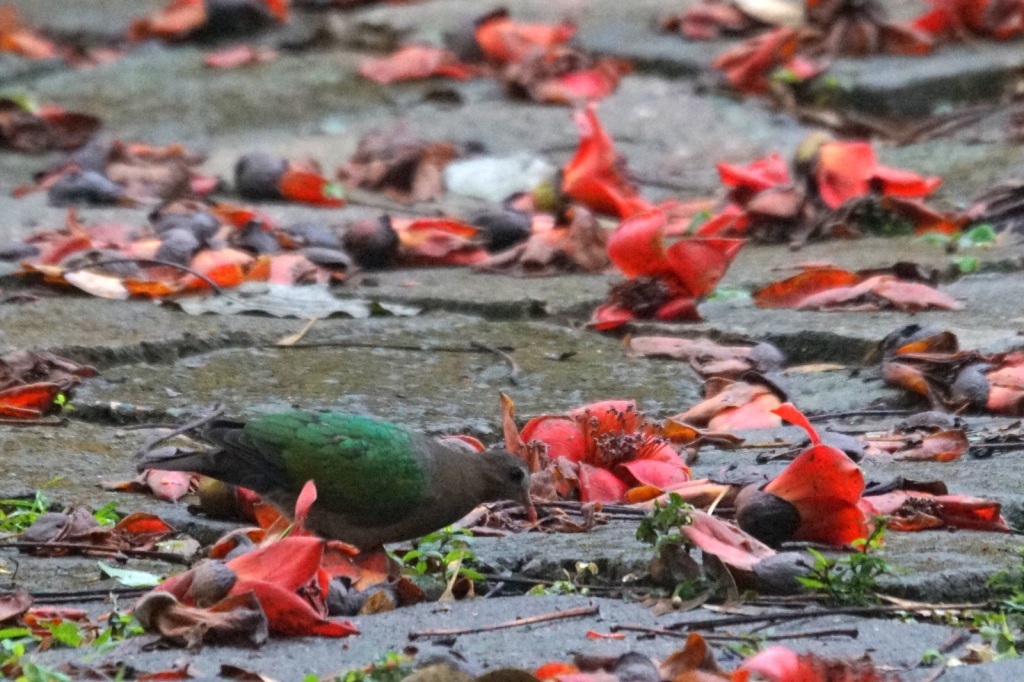
We were no distance from the MTR station now. A Red-billed Blue Magpie flew over just before we got there completing an excellent bird list for the day. I reckon I had exactly 100 species for the day, plus another three heard and the escapee Daurian Jackdaw. With another two species yesterday my Hong List finished on 105. It was great to have John as a guide. Not only did it keep us drier, but we visited a lot more sites than we could independently and had some interesting on birds, cricket and politics.
Our return journey on the MTR was just as smooth and efficient as last time, although this time we managed to get some seats. We visited bakery in the subway when back in Kowloon where I bought an enormous and very tasty banana croissant, dipped in chocolate and with banana flavoured custard in it. We navigated the subways and malls with the confidence of experienced Hong Kong-ers and were back on the ship just before dark.

This was, of course, our first visit to Hong Kong, so we have no idea how different it is to when it was under British rule. I imagine it has got bigger and brighter and bolder and it certainly felt different to Mainland China, although our visit there was over 20 years ago. The famous “two systems, one country” mantra of the People’s Republic is still true in many ways. Hong Kong has its own currency, its own passport, its own immigration rules but as China opens up to Western commerce more and more, Hong Kong’s unique selling point, as far as Mainland Chinese are concerned, is diminished.
Most importantly, however, the political independence of Hong Kong is being reduced. The protests that took place in 2019 have had an opposite effect to that which the protesters desired. They wanted to protect or extend Hong Kong autonomy. But what has happened since has seen Hong Kong autonomy reduced, as the China did not concede, and Beijing imposed new laws in 2020 to try and prevent further protests. The current Hong Kong government kowtows (to use an appropriately Chinese term) to Beijing and, just after we left, they passed a controversial new national security act, despite widespread concerns in the west. Beijing’s dream of, to paraphrase Orwell, “two systems good, one system better” edges ever nearer.
We were due to leave at eight, which meant that we would have been leaving to the sight of the laser show, which we saw for the second evening. Without the low cloud, which had cleared just after dark, it was a much more impressive affair. We even had a junk sail past, although I suspect it was just a modern replica. It was, in some ways, just another reminder of how Hong Kong has changed. The old image of a harbour full of junks and crowded streets with open markets and street food has been replaced by a shiny antiseptic modernity. The two days were still some experience though.

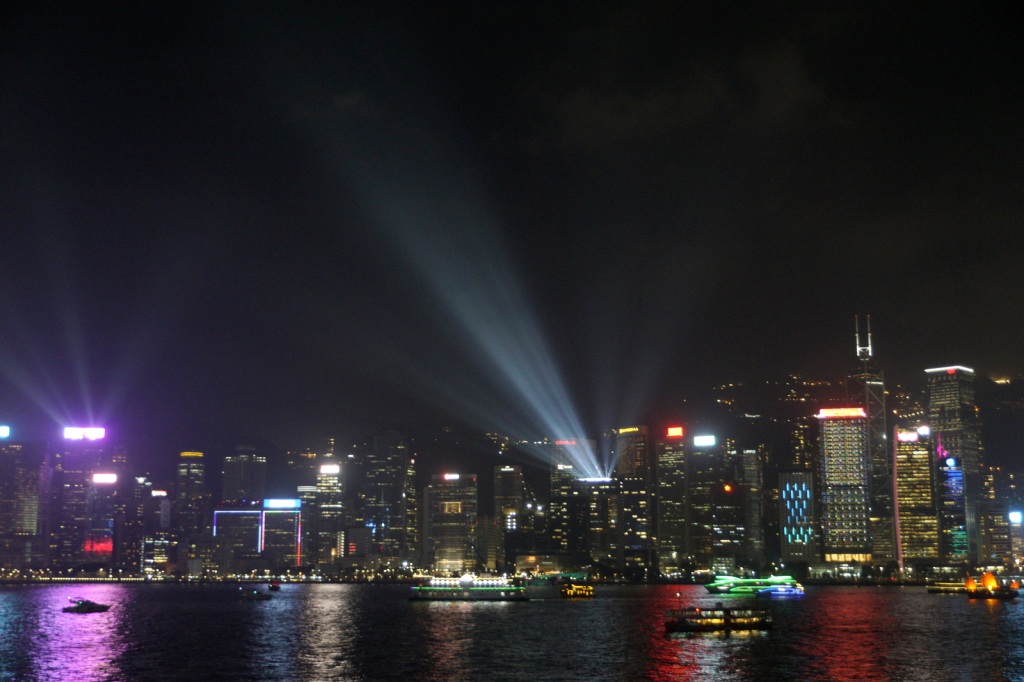

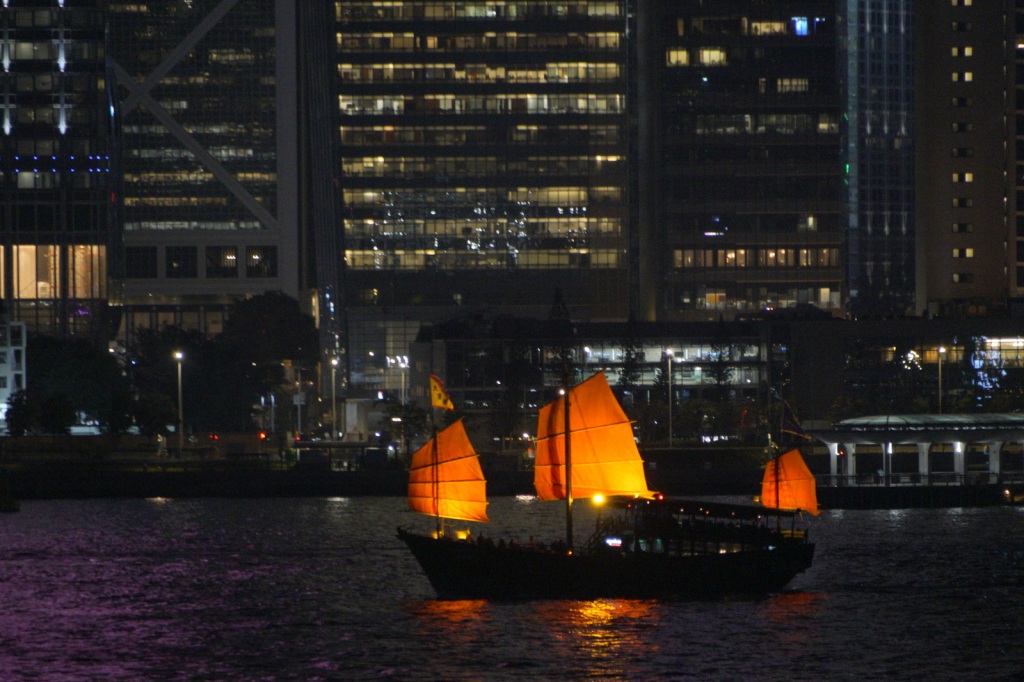
We did not leave at eight, however. We know, from a ship’s announcement, that twelve people did not return their passports after visits to Macao or Mainland China. The next day, it was just immigration problems that were being blames, so maybe it was more complicated that. We did not leave until about midnight – four hours later than scheduled.

